This (awesome and huge) tree fell down in a storm at the start of 2025:
Stump cut:
Trunk cut in to sections for milling:
Gaps cut out and removed between the sections so I can get the mill in, and some firewood removed:
DevOps, CI/CD, Kubernetes, Docker, Jenkins, Woodcraft, and my CV/Resume
This (awesome and huge) tree fell down in a storm at the start of 2025:
Stump cut:
Trunk cut in to sections for milling:
Gaps cut out and removed between the sections so I can get the mill in, and some firewood removed:
Storm Isha left an obstacle that needed cleared up in a hurry, here are some pics!
In the early hours of the morning, blocking our way out past our neighbours farm at the end of our track:
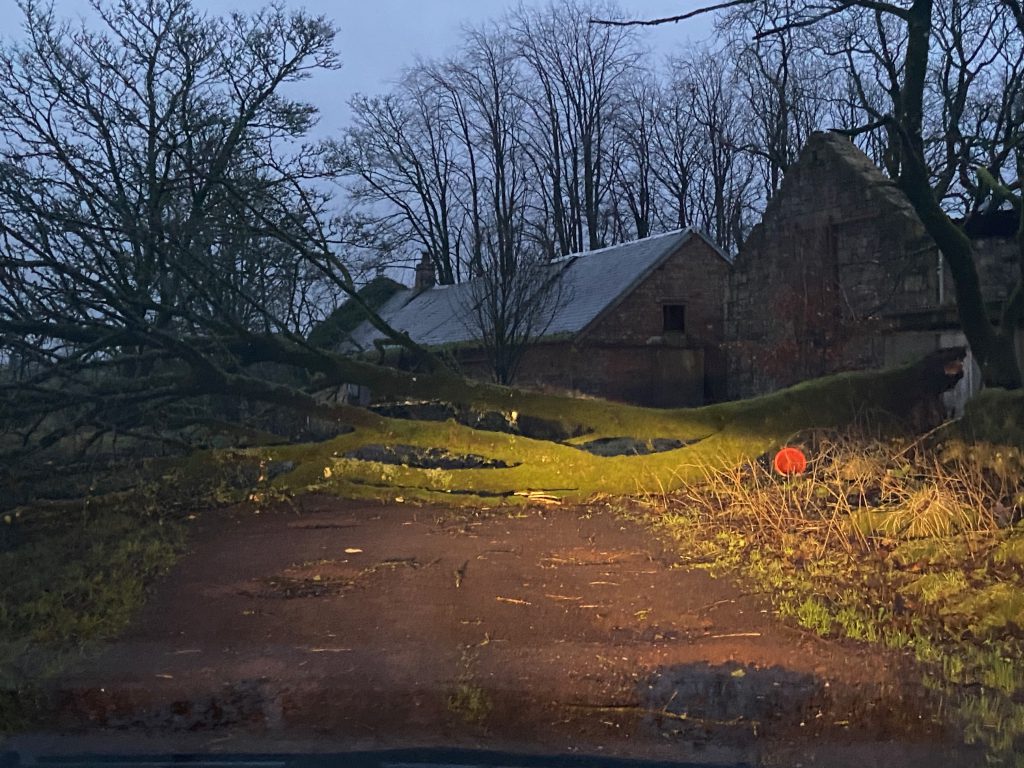
This was the start of my “lunch break”:
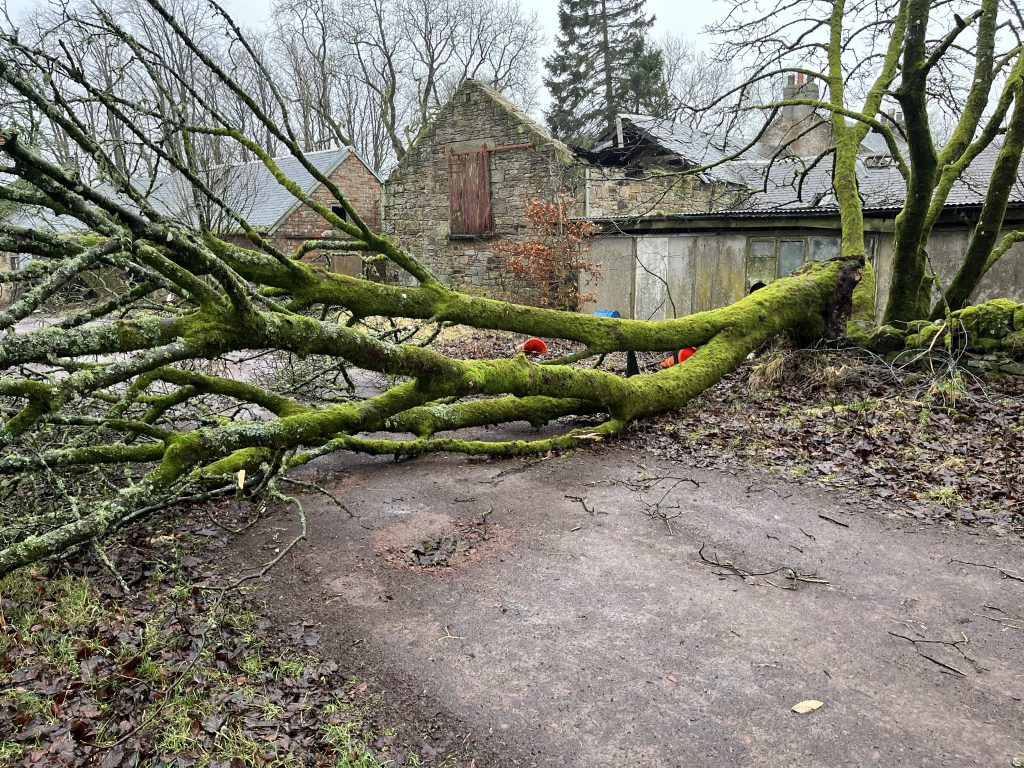
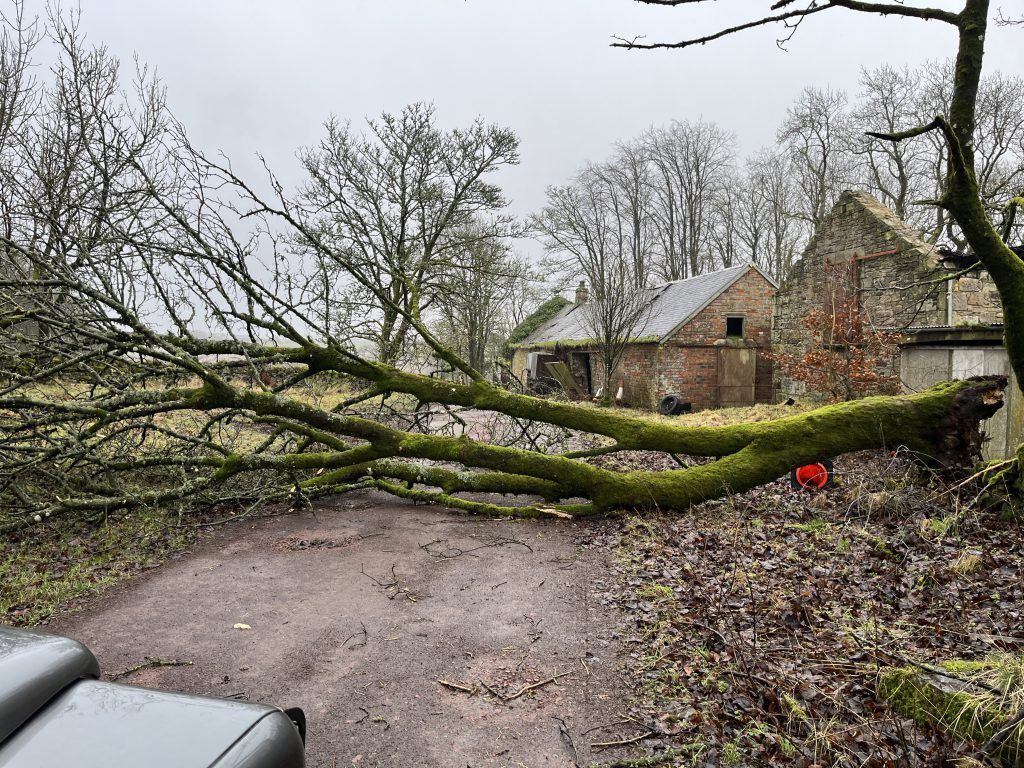
Things went quickly, this was about half way through:
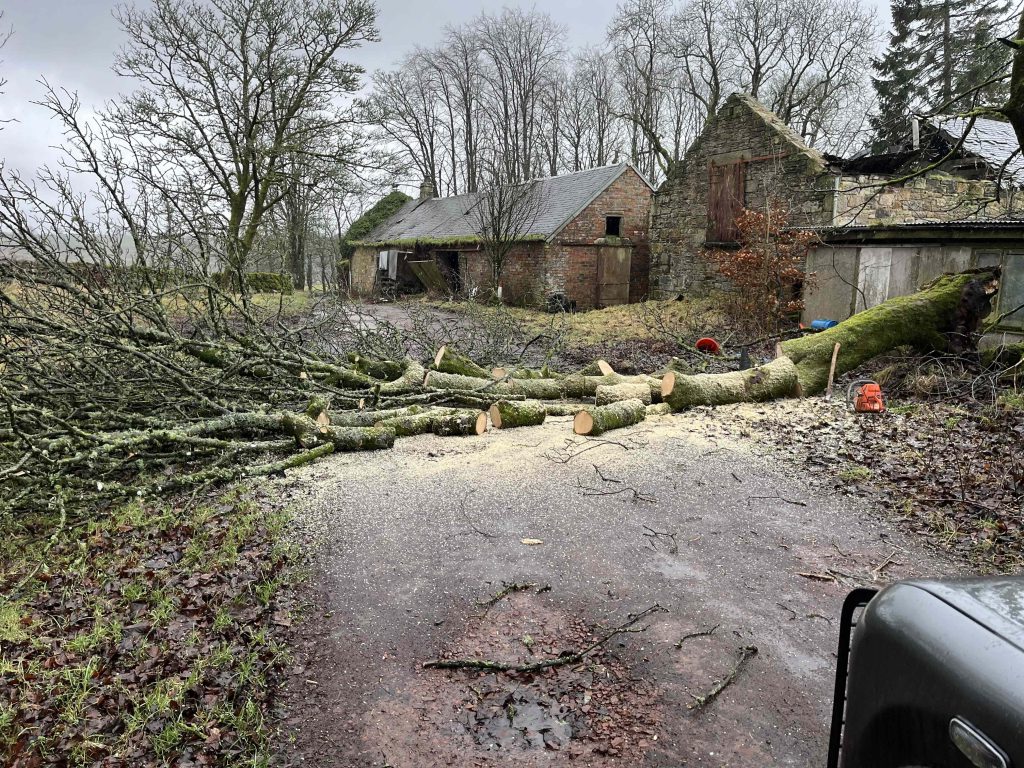
All packed up (nearly – I went back for those big bits later!) and off back to work with about 10 mins to spare….
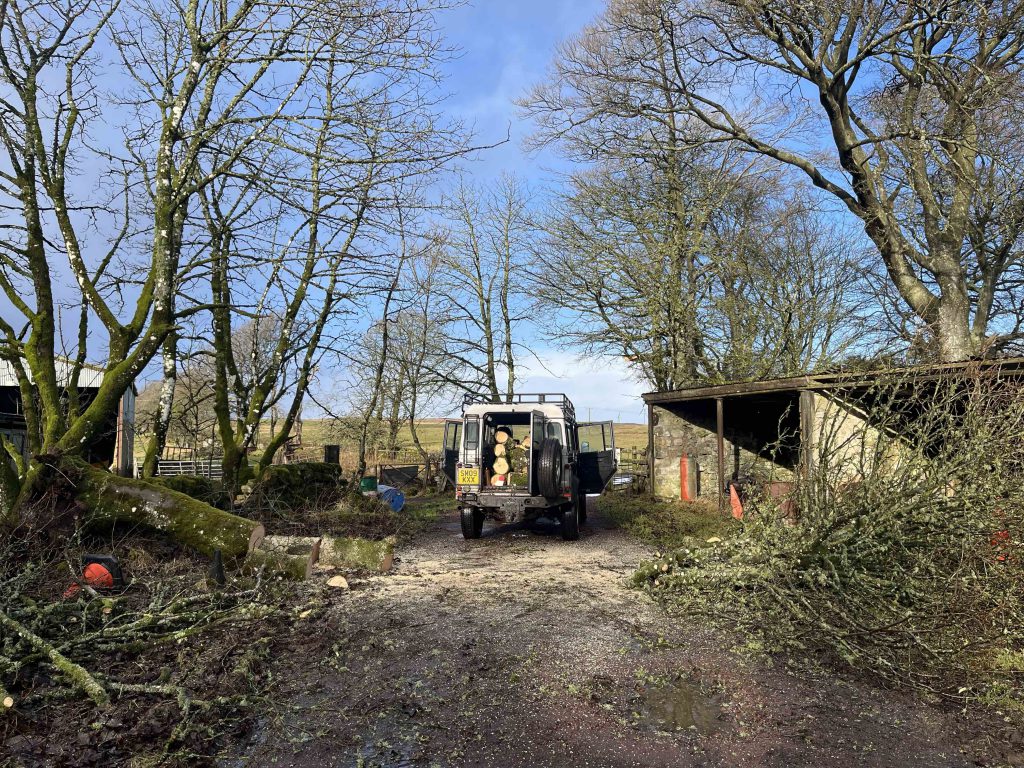

Pics and updates on milling a large beech tree trunk.
This is the trunk section of this massive tree that blew over in a storm back in 2019:

I posted progress on other things made from this tree here too:
https://www.donaldsimpson.co.uk/2020/07/27/slabs-sleepers-and-stumps/
These giant chunks of wood have sat patiently outside my shed for the last 2+ years, like a massive looming todo list…
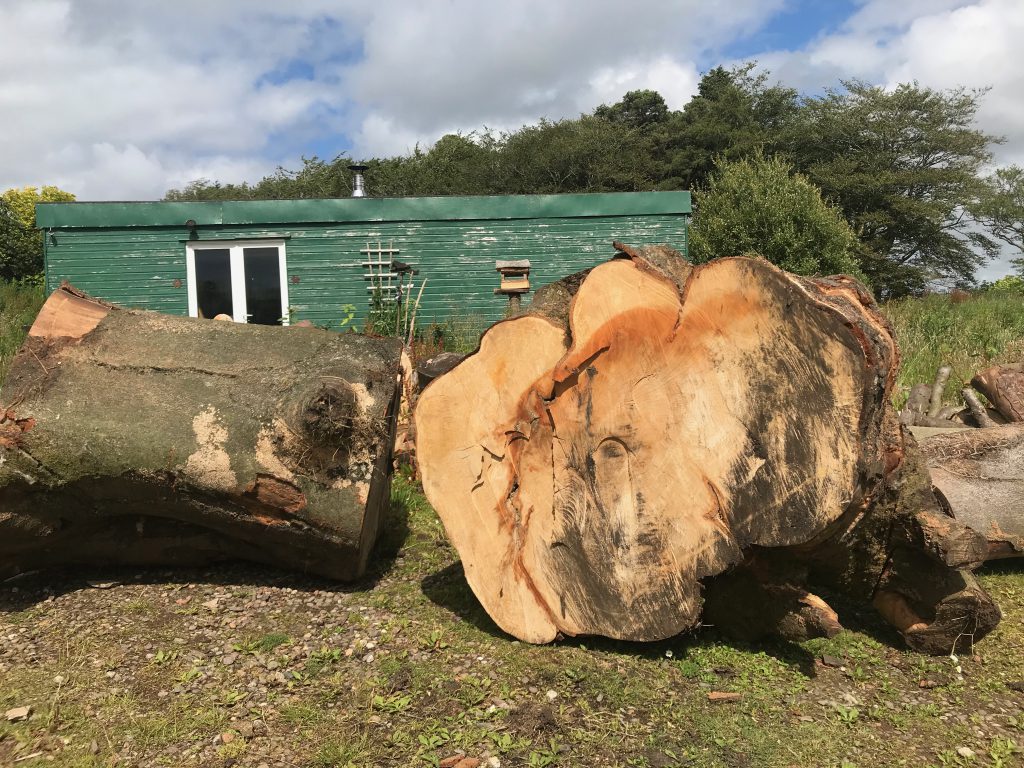
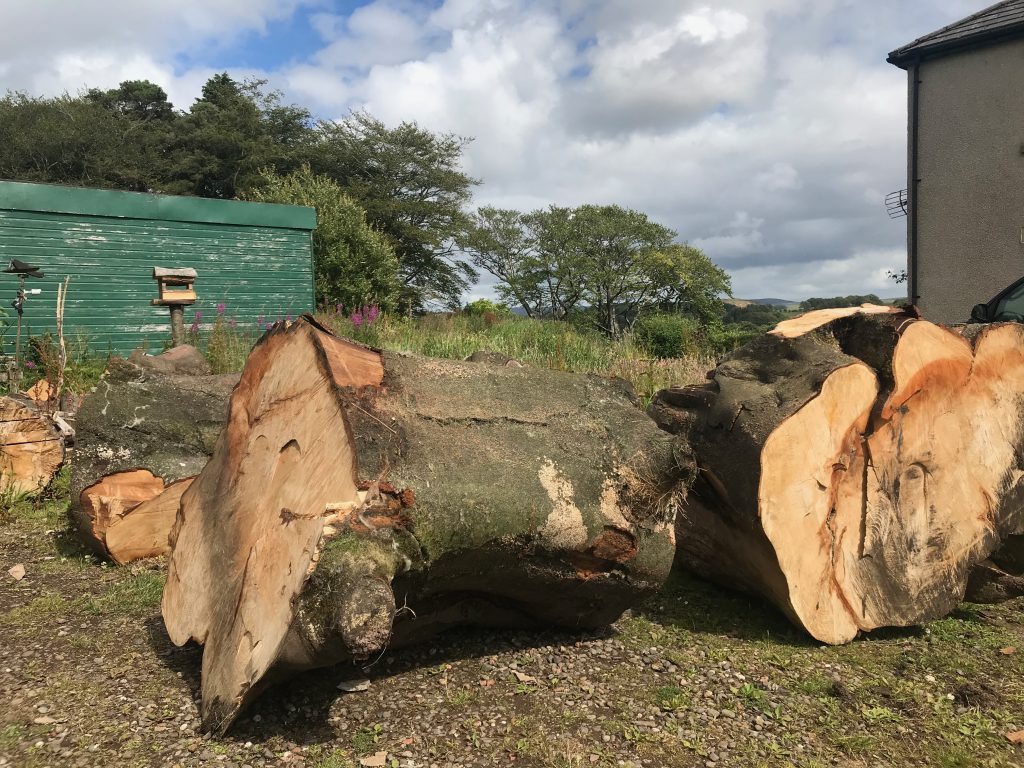
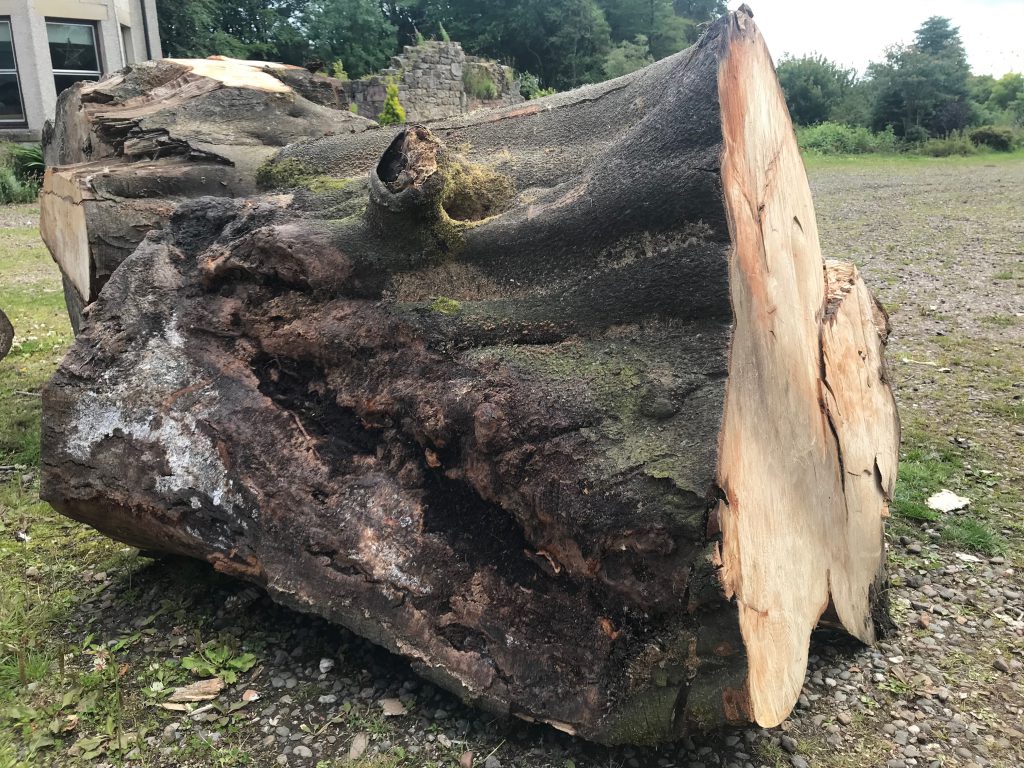
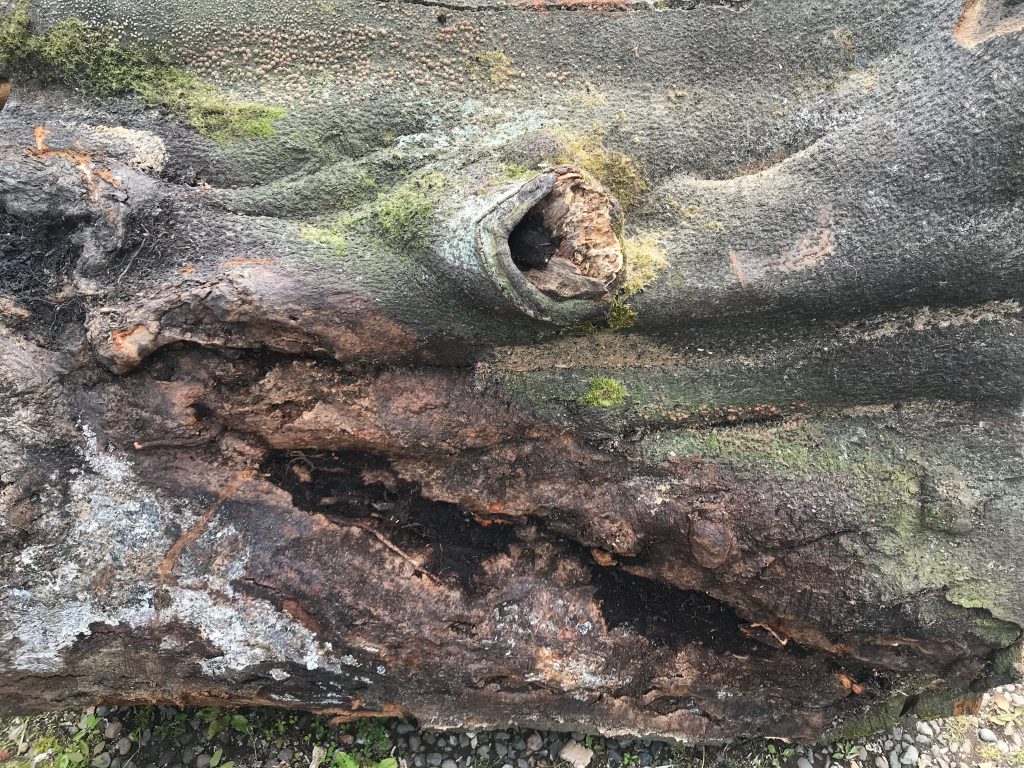
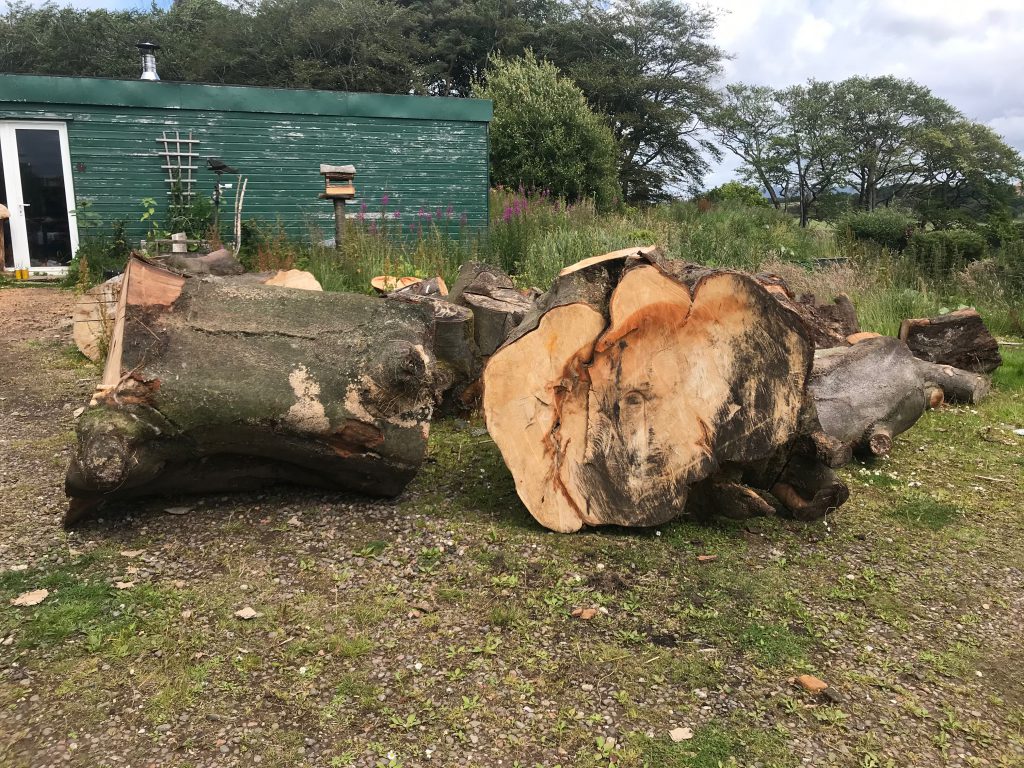
Now this (and a lot of sawdust) is all that’s left in the spot they occupied for so long:
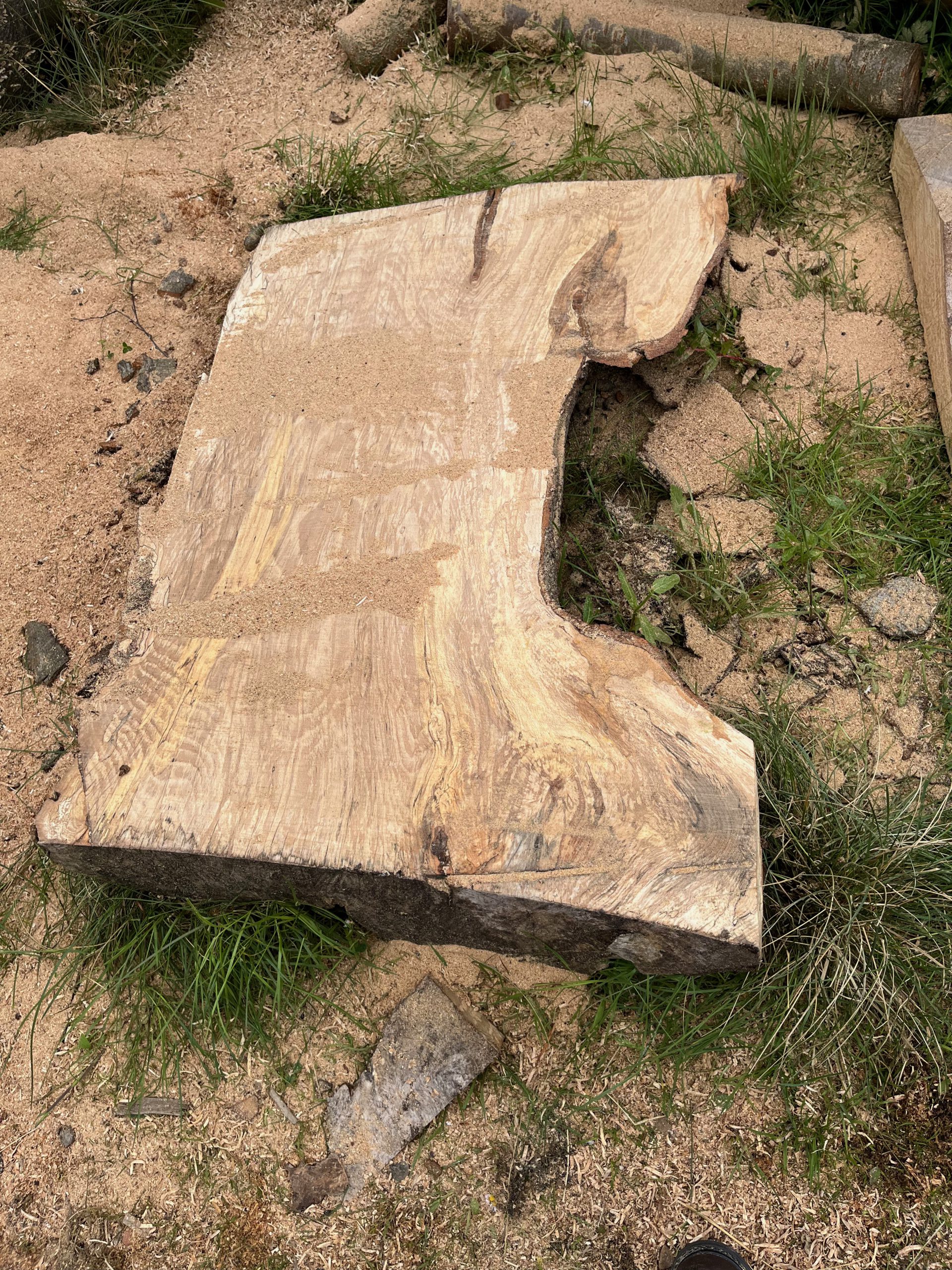
It took me years to get around to it, but only a couple of Saturday afternoons to mill it all.
I used my Husqvarna 365 X-Torq chainsaw, along with a 42″ low-profile bar fitted with a 3/8 Lo Pro .050 ripping chain with 137 drive links… 137… I am not looking forward to sharpening that!
This, for me, is a whole load of bar and chain to run. It more than maxed out the cutting width of my Alaskan Mill setup, which was just a little too short to cope with the widest parts of this trunk, so I had to take a couple of edge sections off.
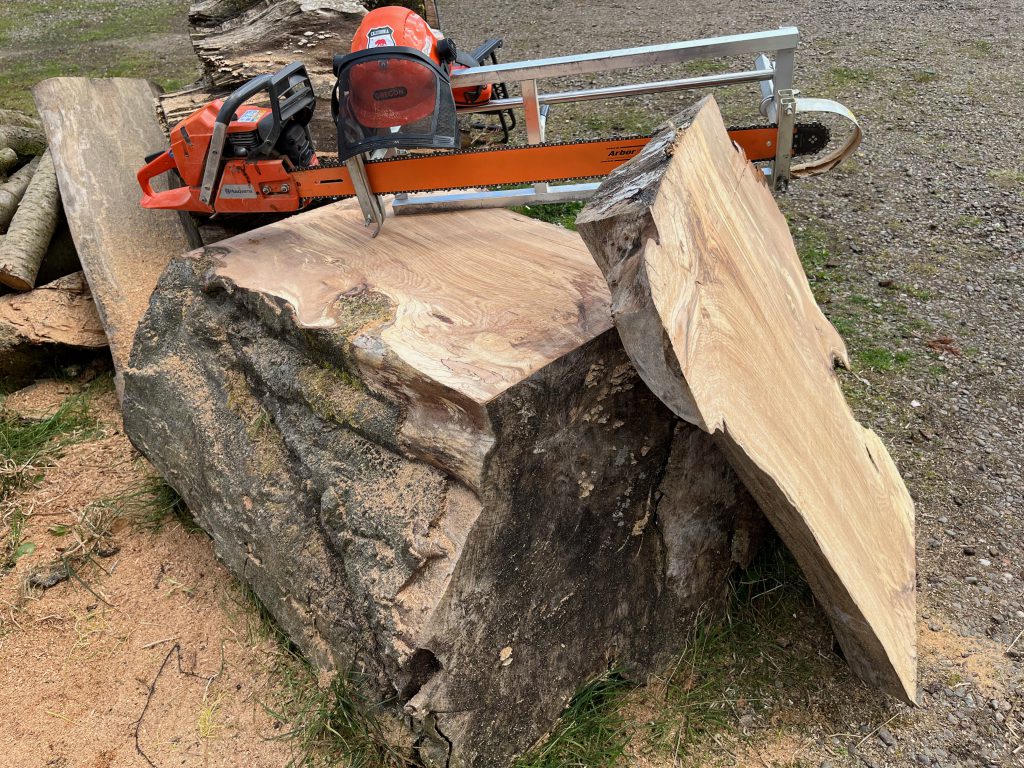
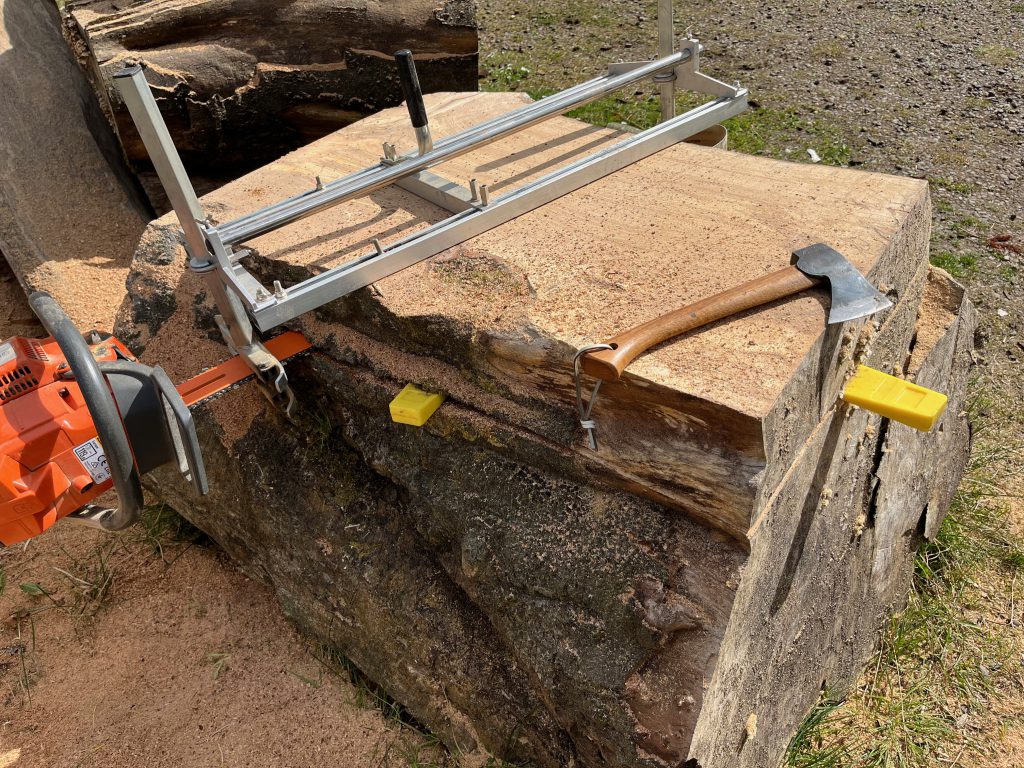
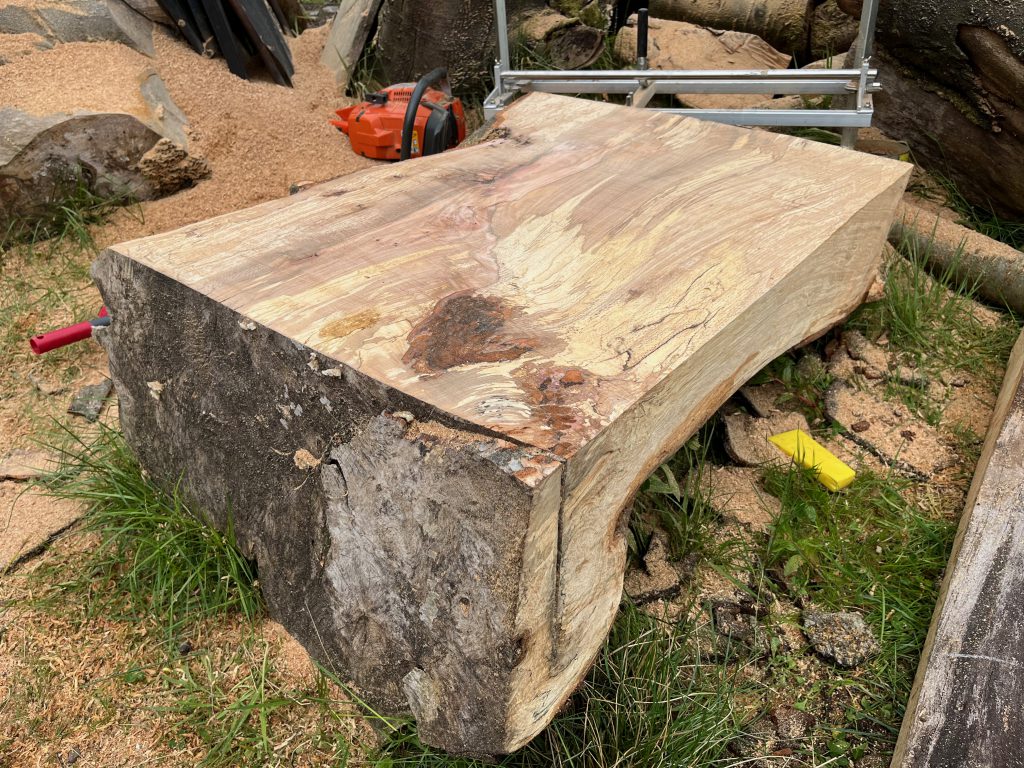
The Husqvarna 365 did a great job getting through this much solid beech wood – I expected more of a struggle, but as long as I took it slowly and used wedges to keep the weight from pinching the bar & chain, it chugged through it no problem. Having the trunks at a slight angle meant that gravity lent a hand too.
Great chain and bar from https://www.chainsawbars.co.uk/ along with their usual great service and helpful advice too, thank you again guys, this worked perfectly.
Here are some of the slabs that were produced – I don’t think the pics properly show how big these are, and they definately don’t convey the weight of them! I had to ‘walk’ the thicker ones over to the shed, one corner at a time.
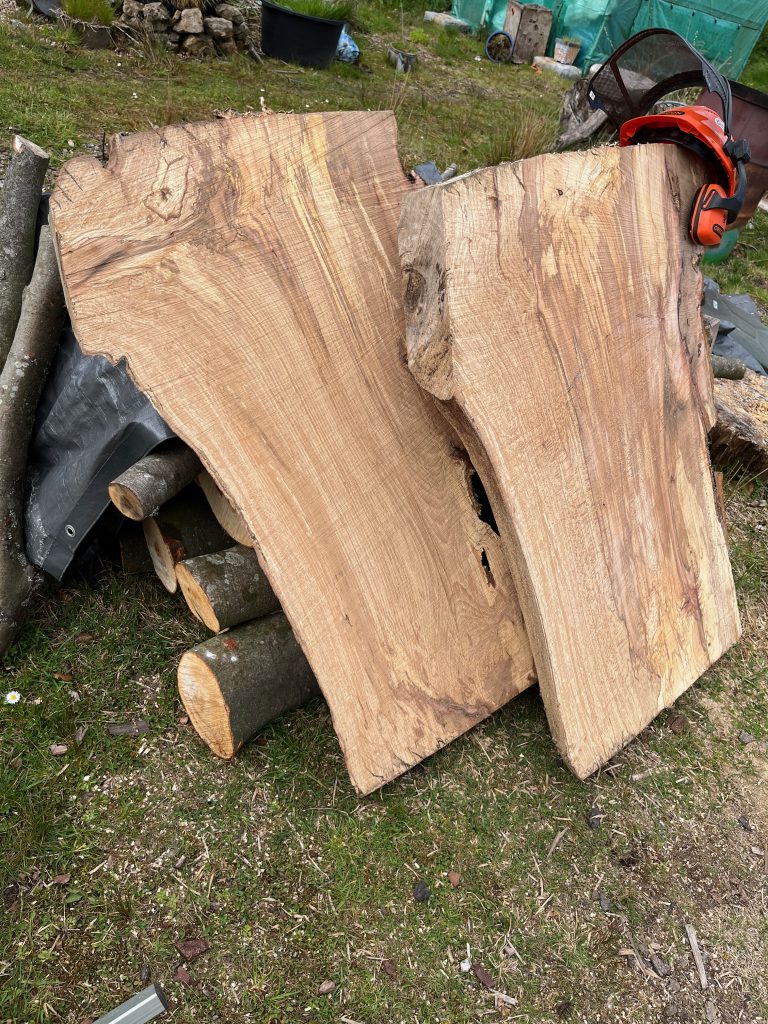
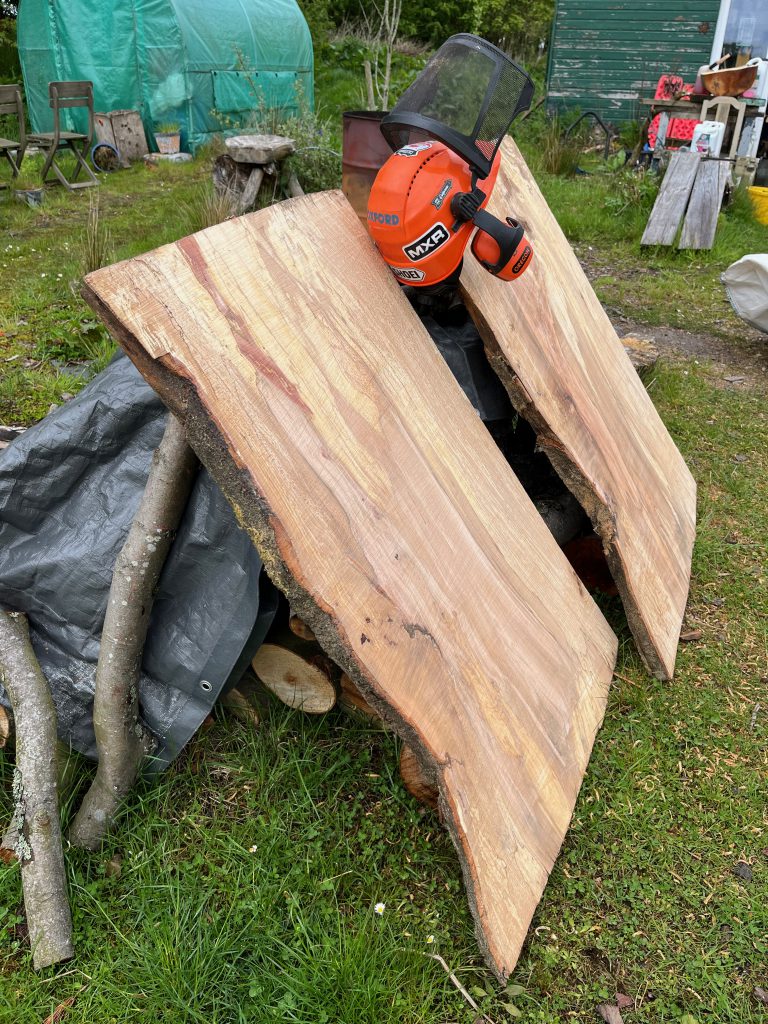
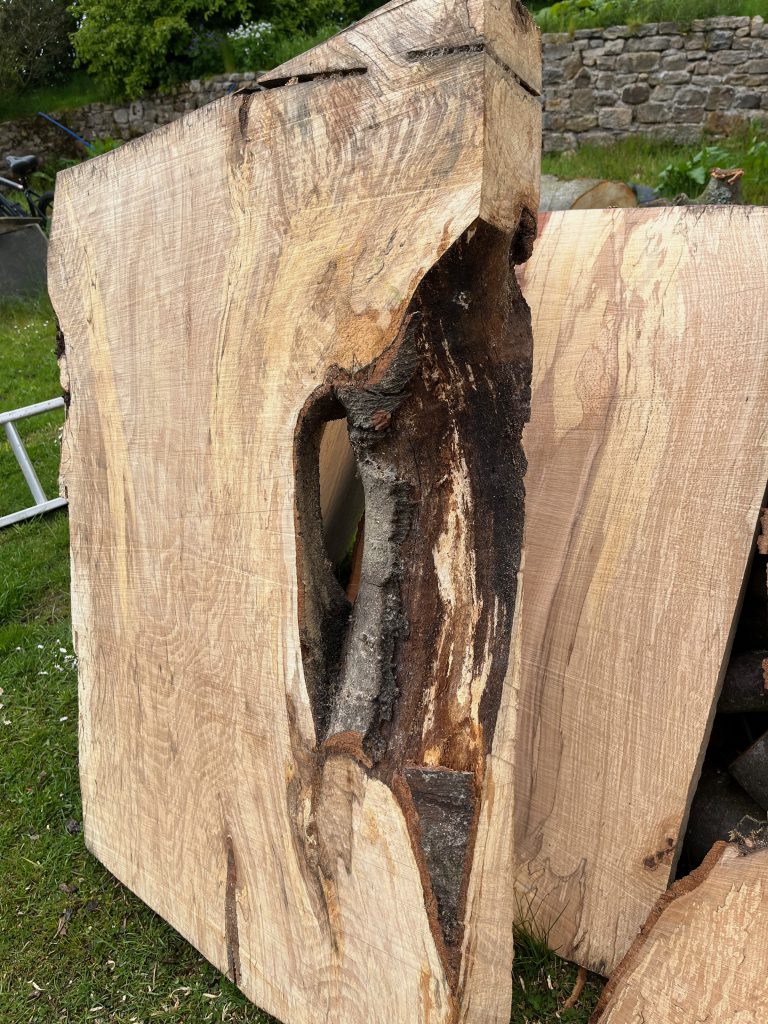
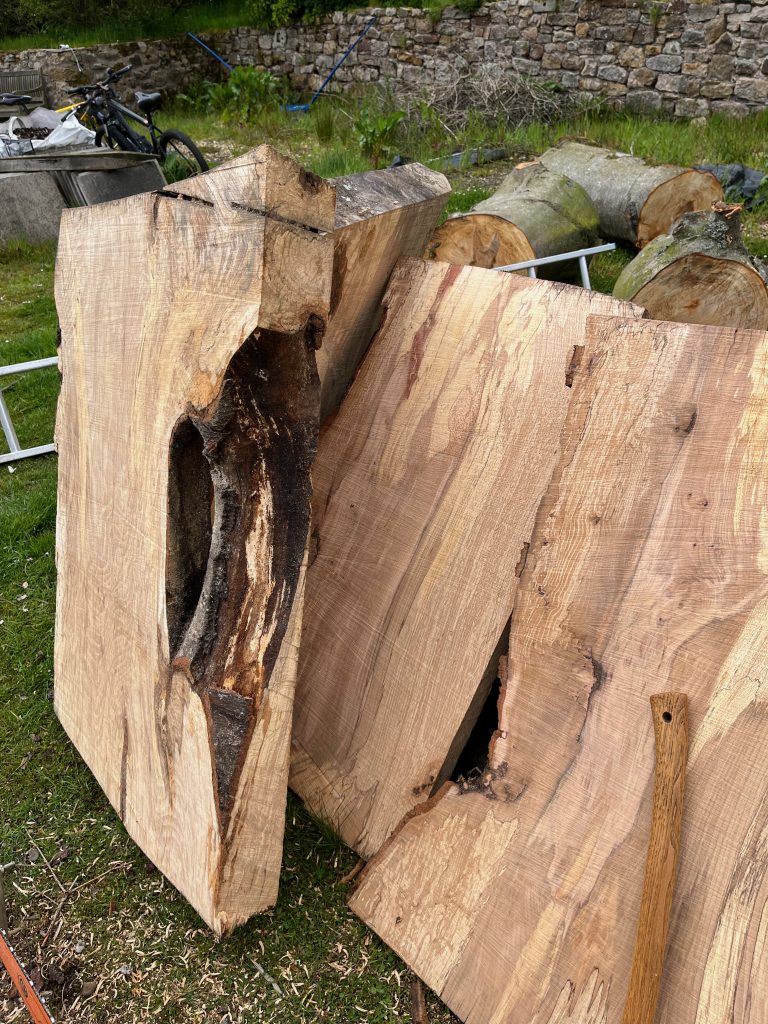
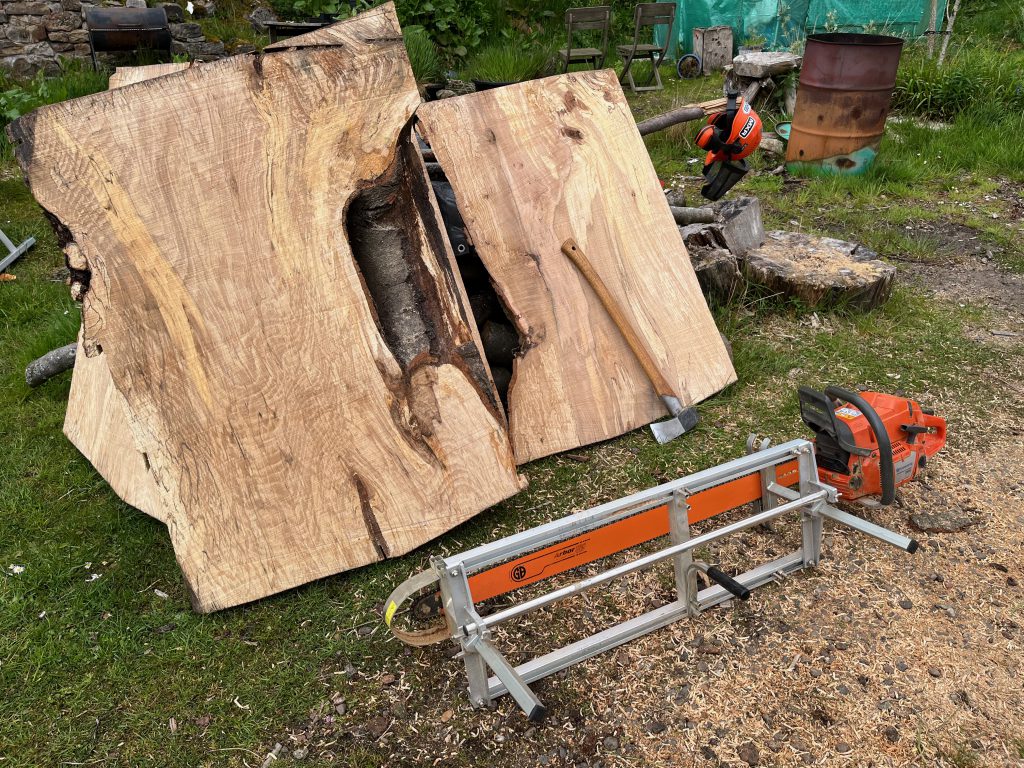
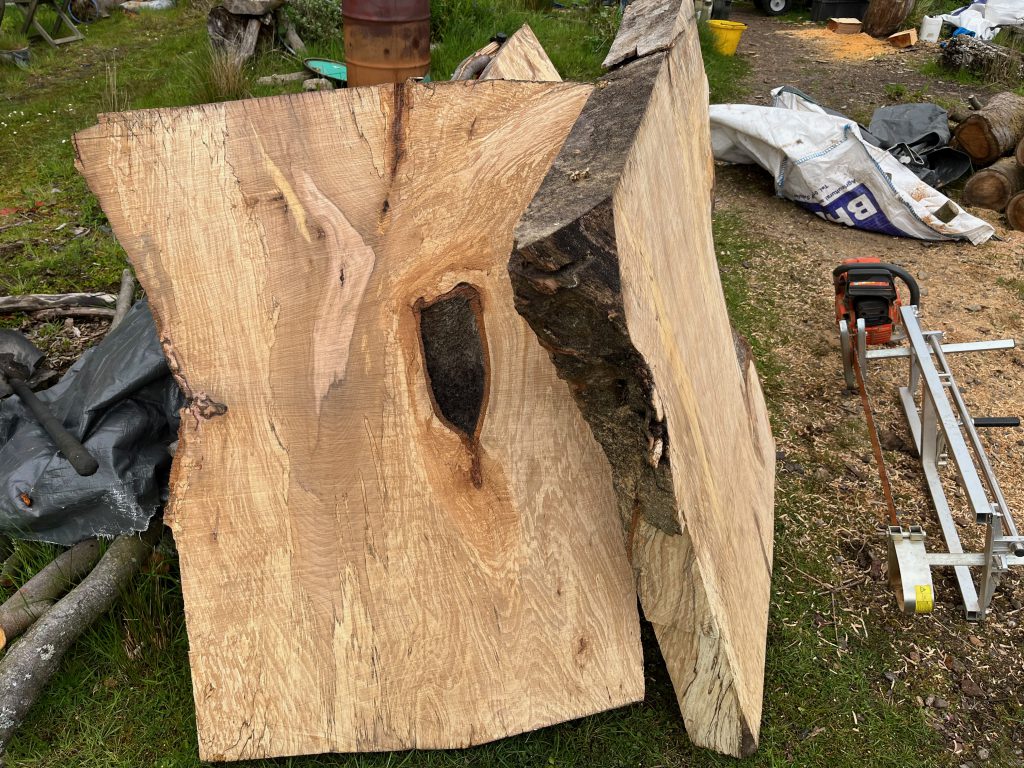
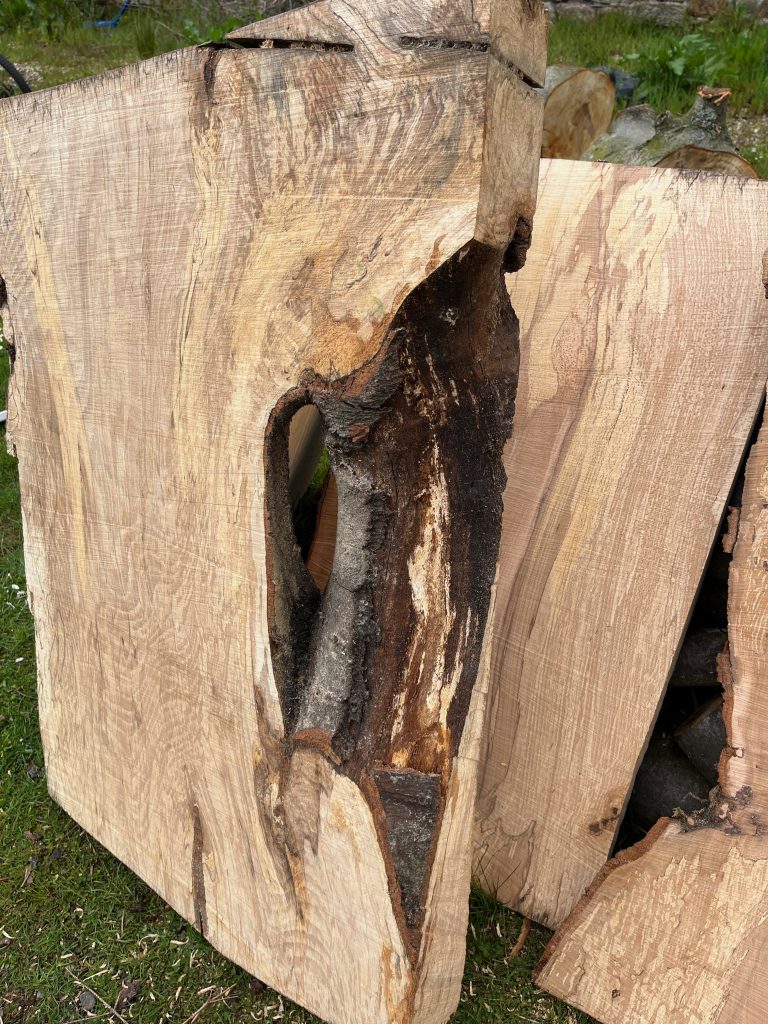
These slabs are now stacked, spaced and weighted in my wood shed with a dehumidifier and fan on them (running off my small solar setup!). Hopefully in a year or so I can try giving the thinner slabs a final flattening with the router sled then turn them in to tables.
I’m hoping that void and inclusion on two of the slabs could work out quite nicely too – I’m not normally a fan of epoxy resin but this could be a good place for it? Maybe? Or just go with the ‘feature’ perhaps?
There are three 4″ thick slabs that will take even longer to properly dry, but if they don’t warp or split they should become very characterful – and heavy – tables.
To fit these in to my shed I had to take out a load of planks I milled a couple of years ago, many of which have come out nice and straight – so making something useful from those is now next on the todo list. My wife has already placed an order for some waney-edged bookcases for the Yurt… possibly curved to match the walls… ?!
Cleaning up a beech tree that fell over in late 2021 during storm “Arwen”, squishing some stock fencing. There were ditches on both sides so getting the tractor close enough to be much help was awkward, but I used it to drag out the thickest trunk sections and bring things home. I plan to mill the trunks in to slabs, and will add pics of that (and whatever becomes of them) to this post.
Pics of the fallen tree and damaged fence
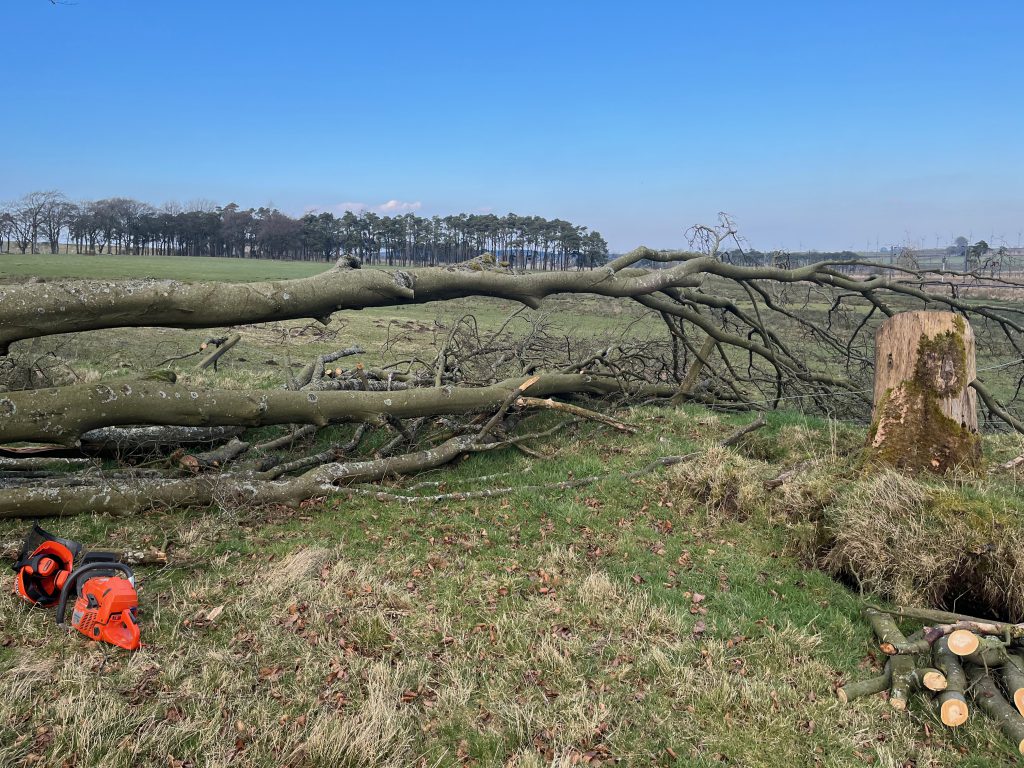
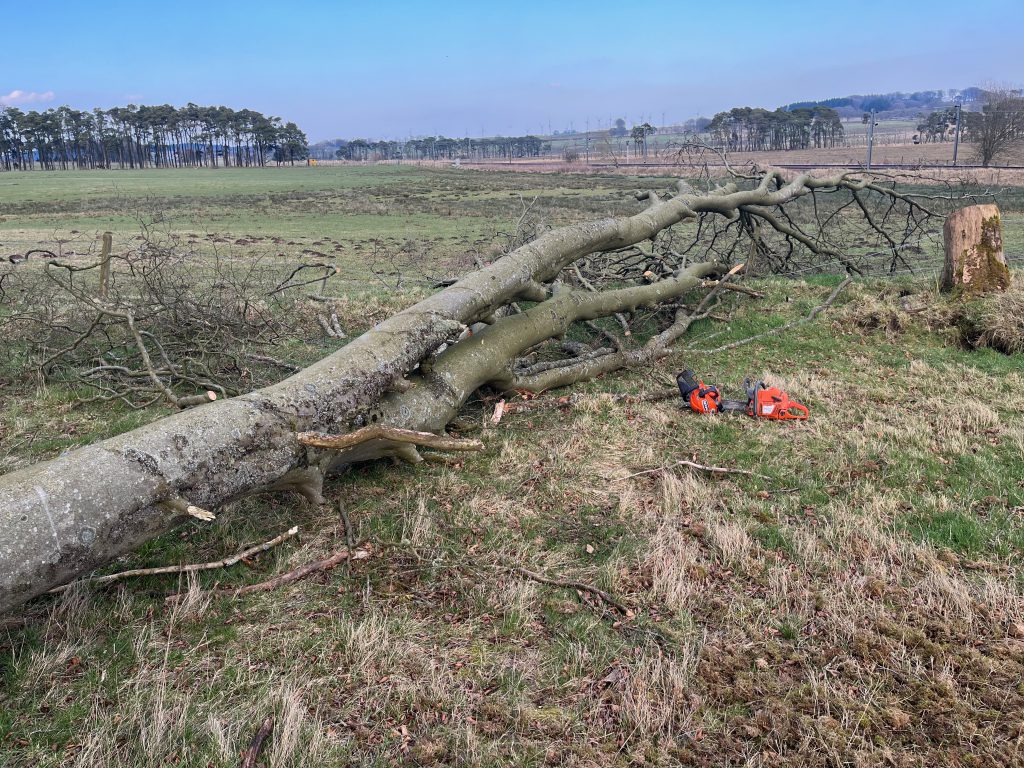
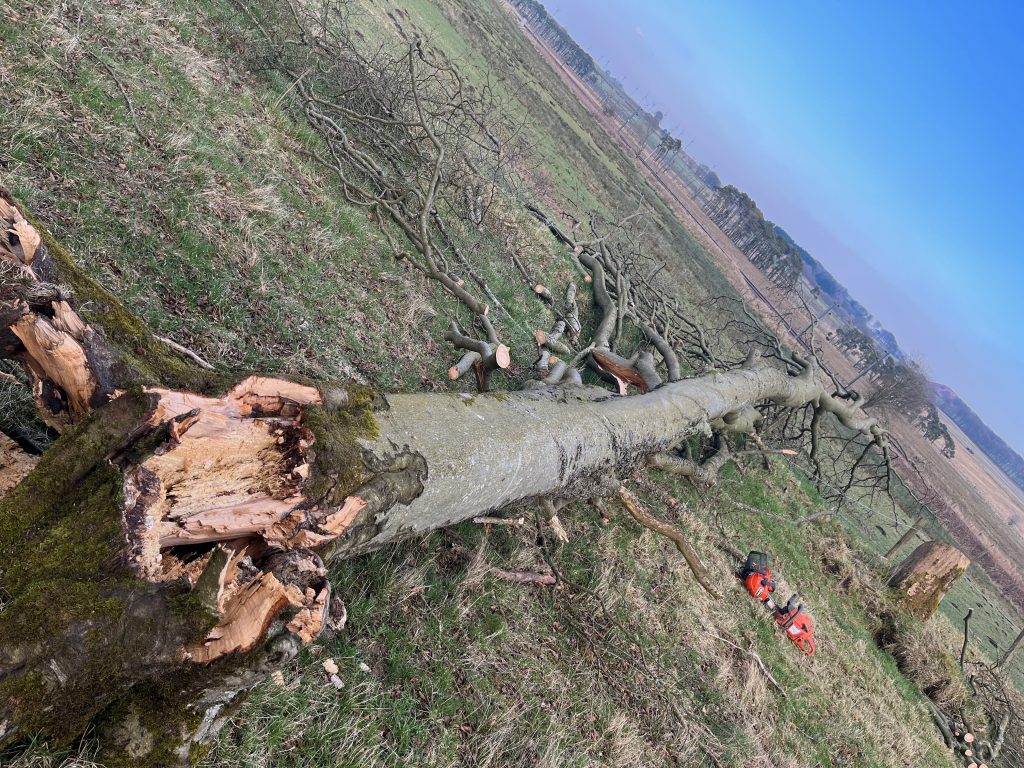
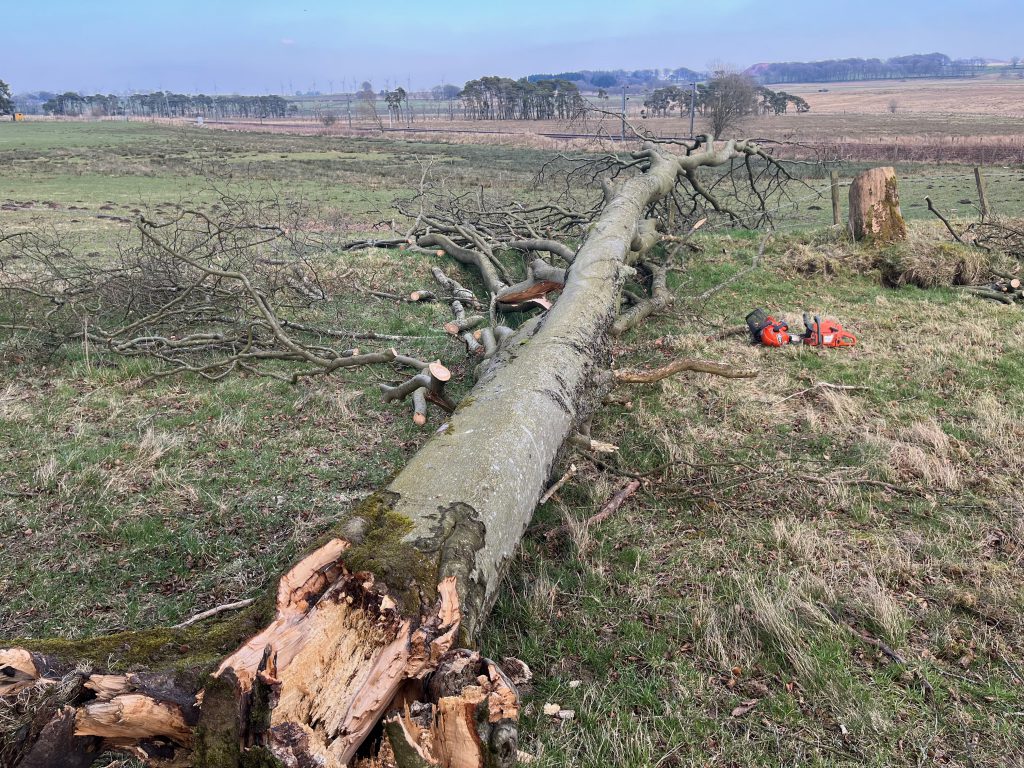
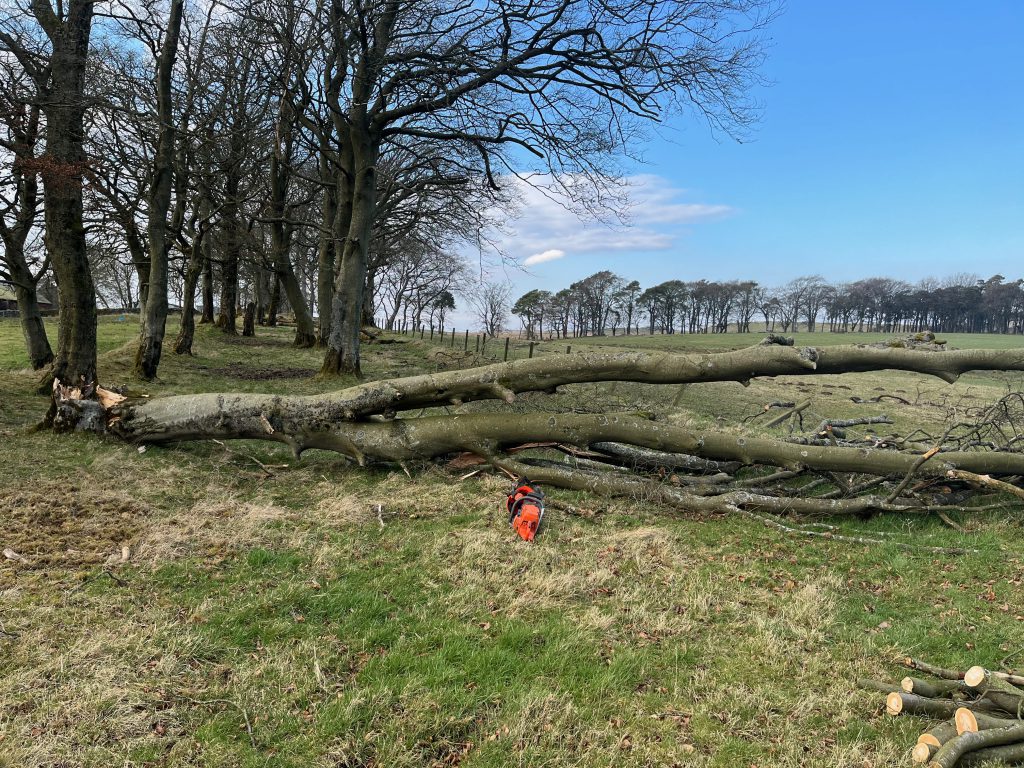
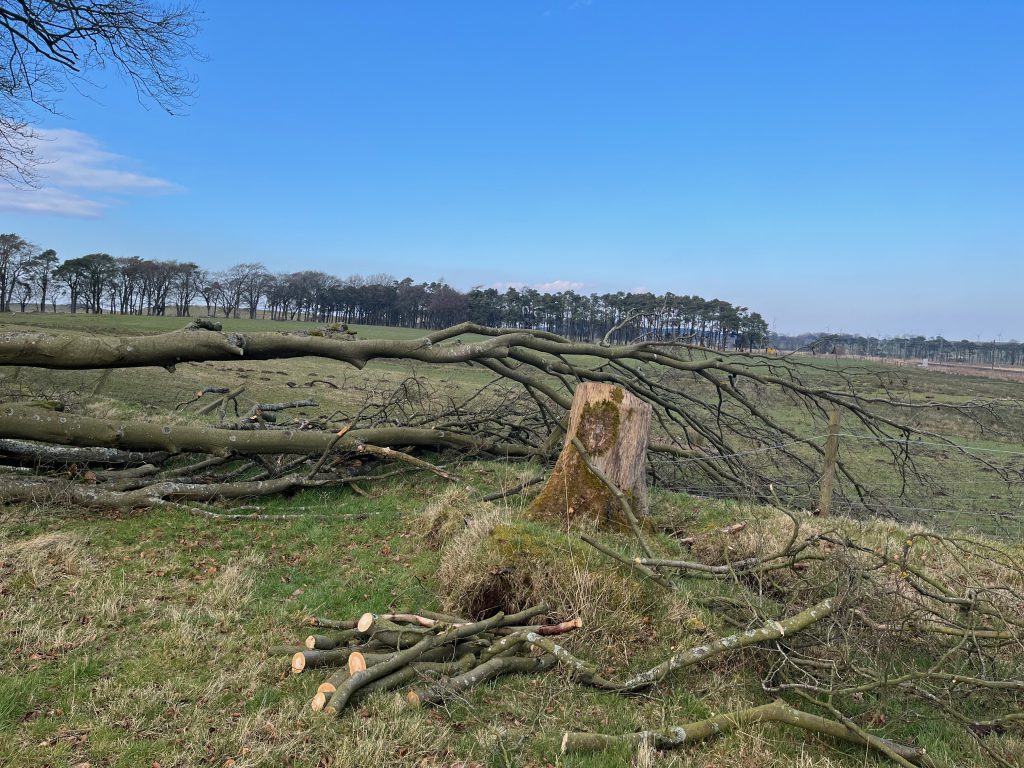
Progress pics – a fun day or two of chainsawing and throwing logs around…
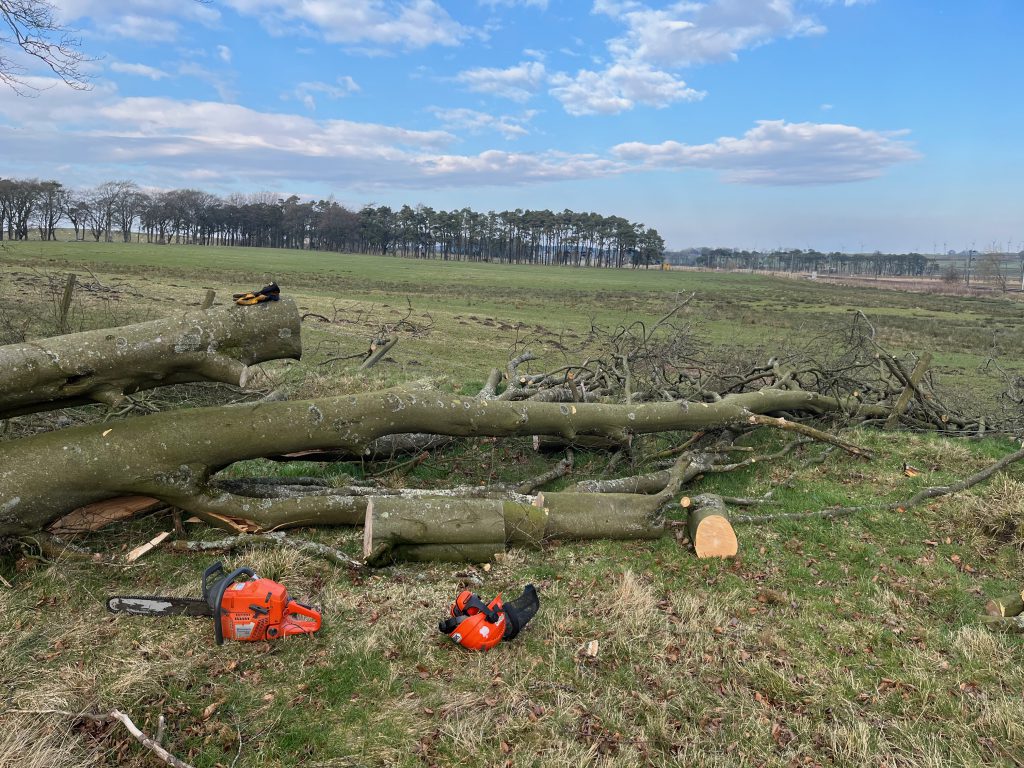
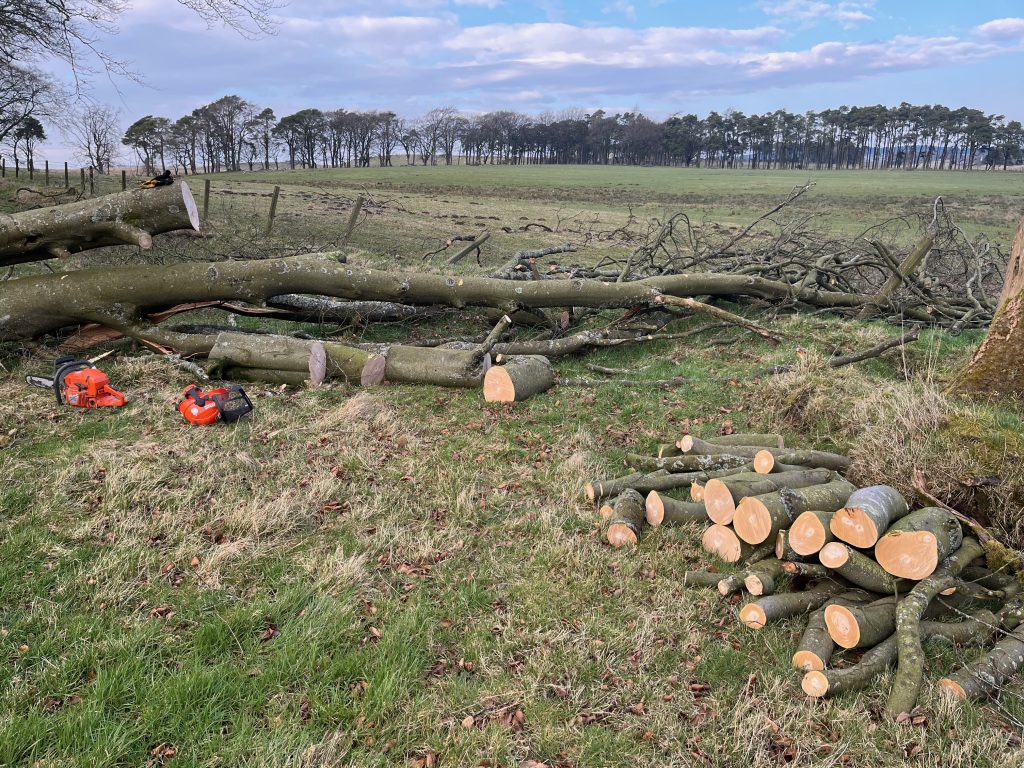
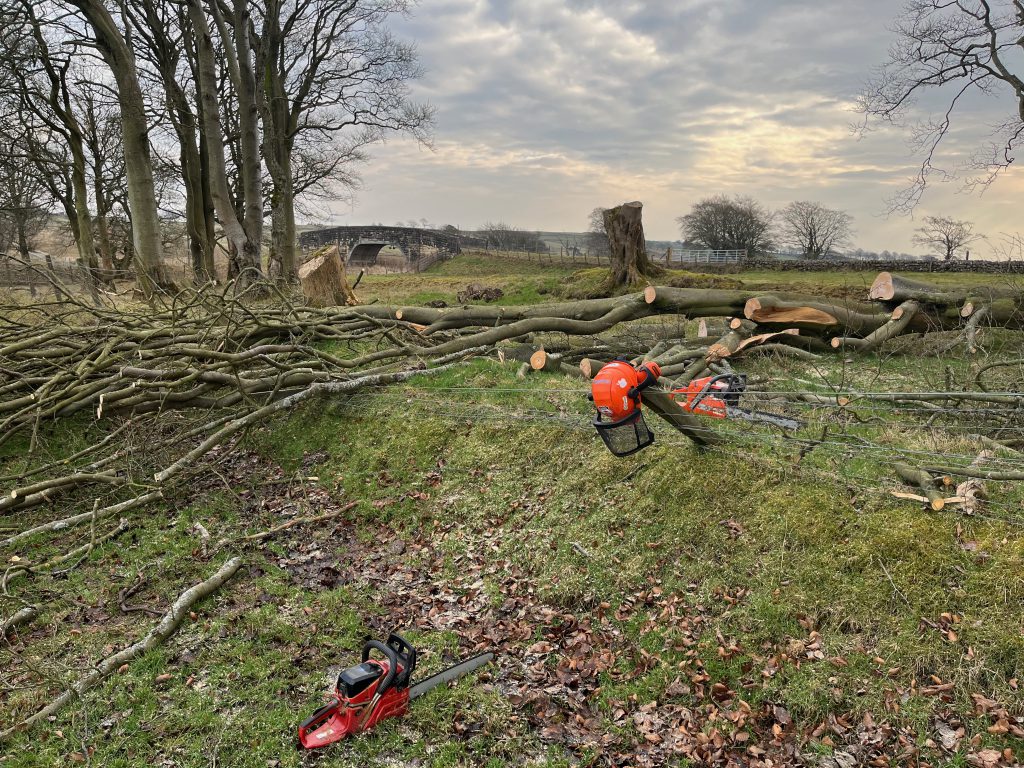
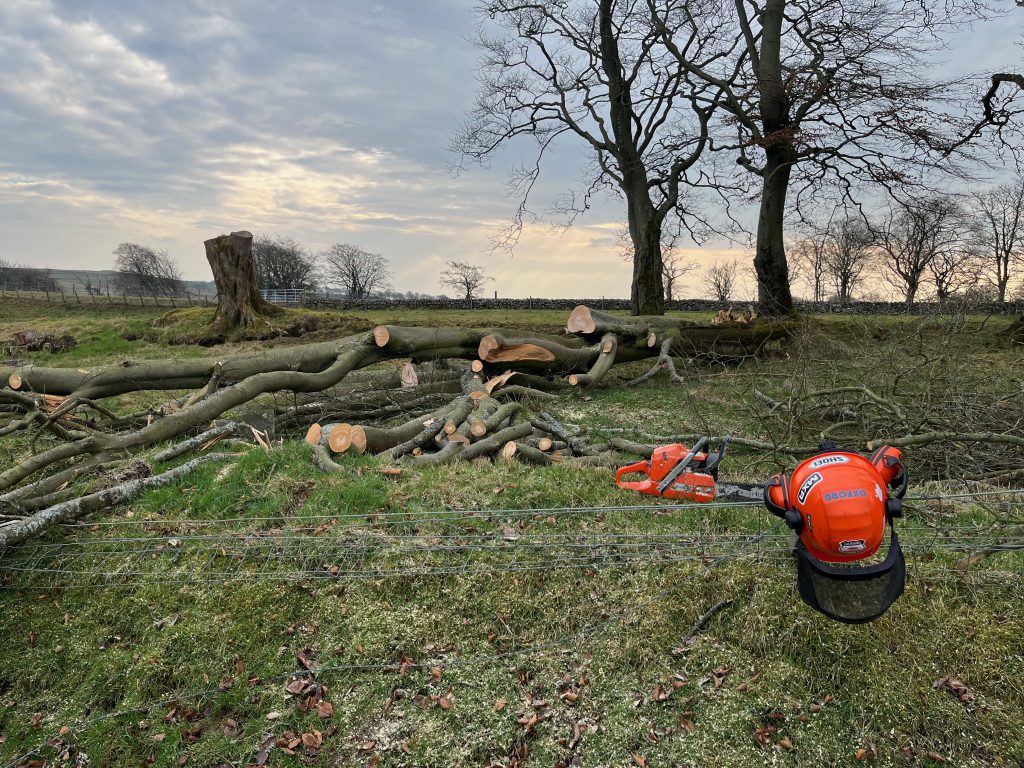
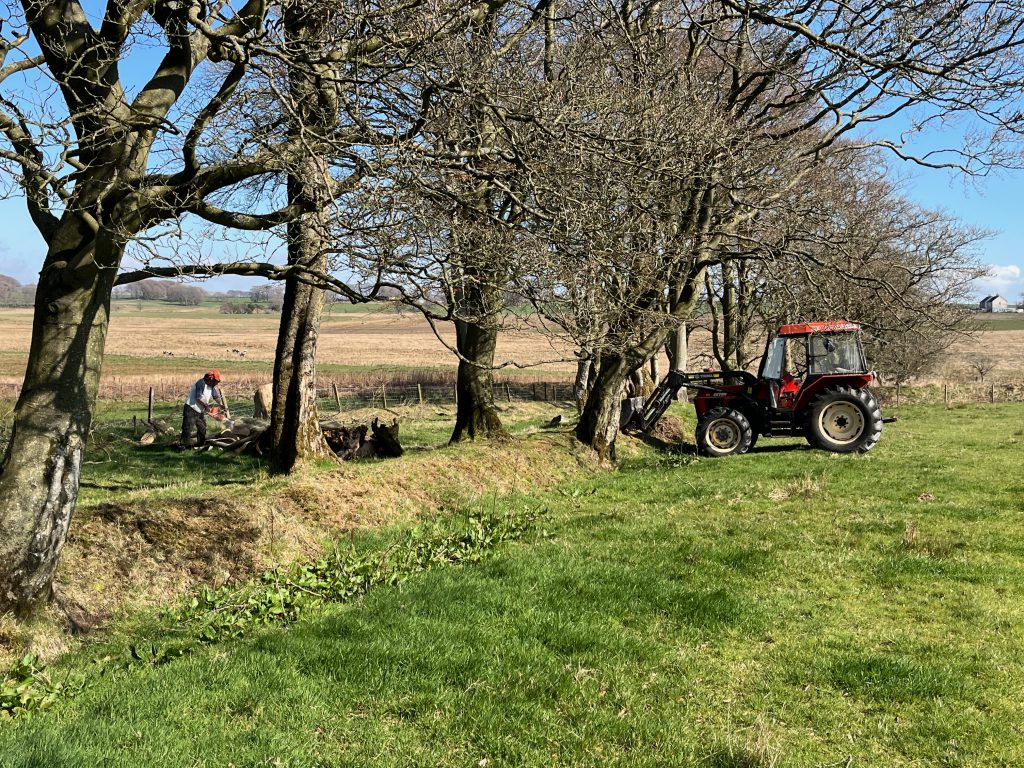
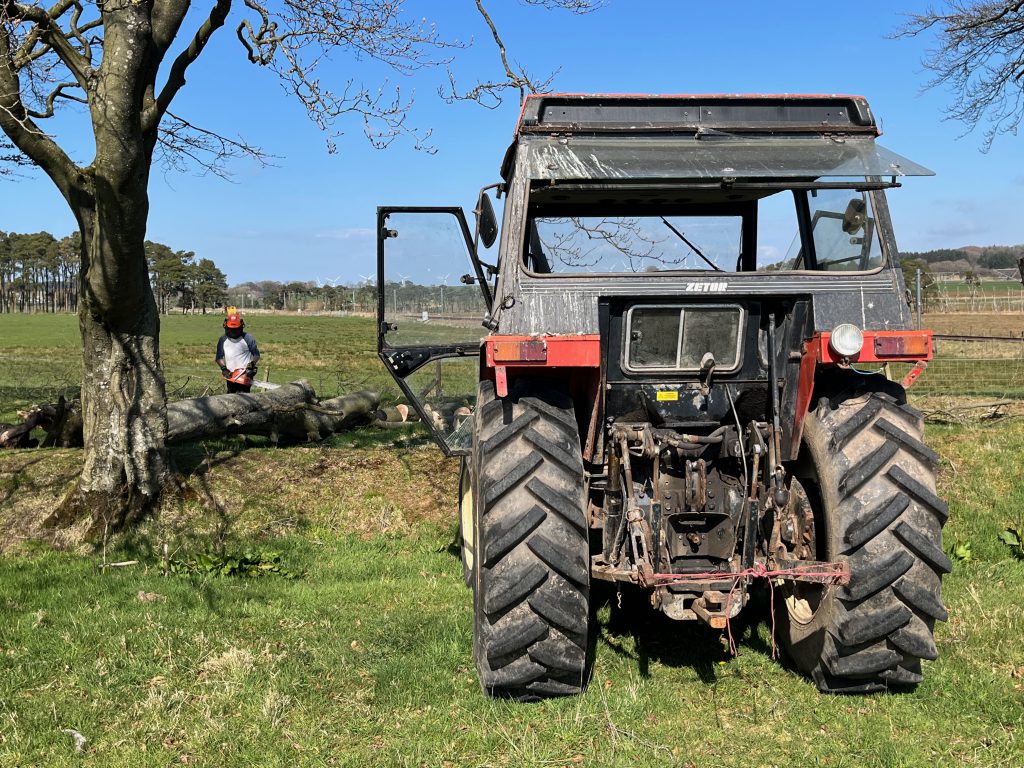
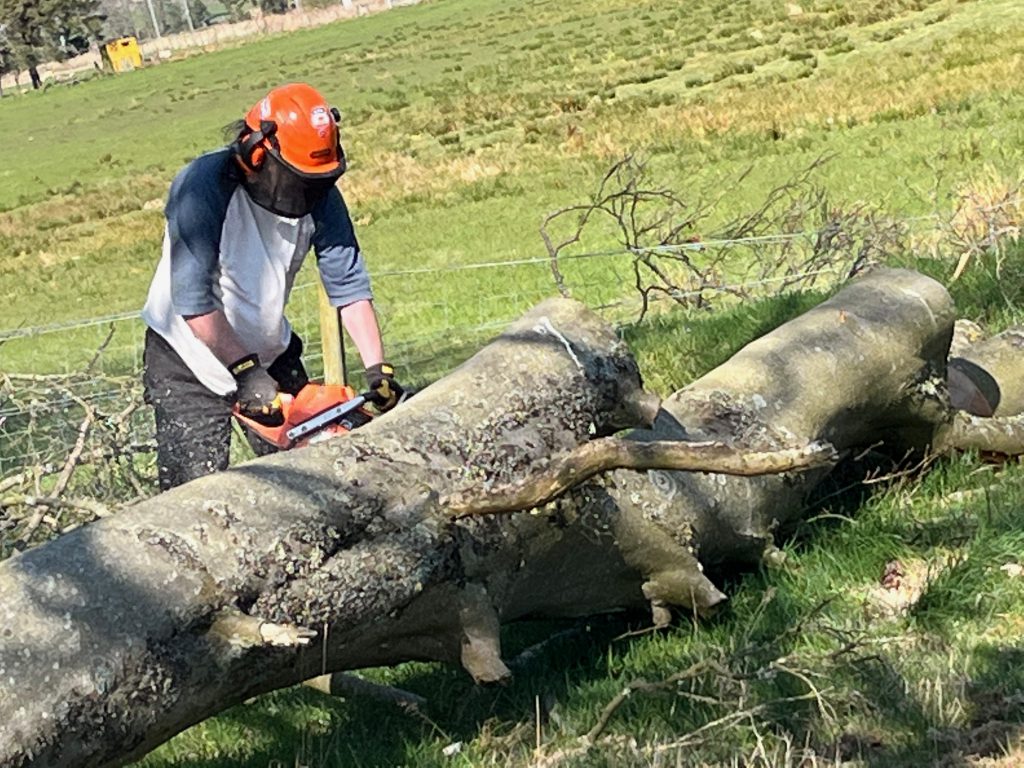
Bringing things home – mostly firewood but a few big sections…
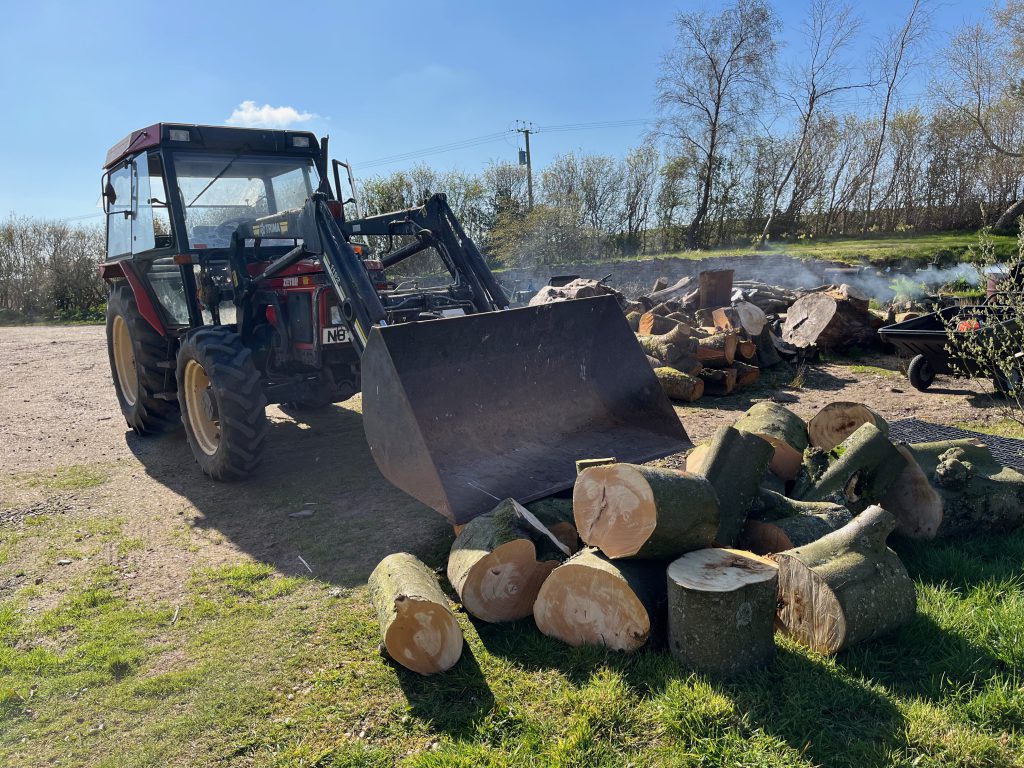
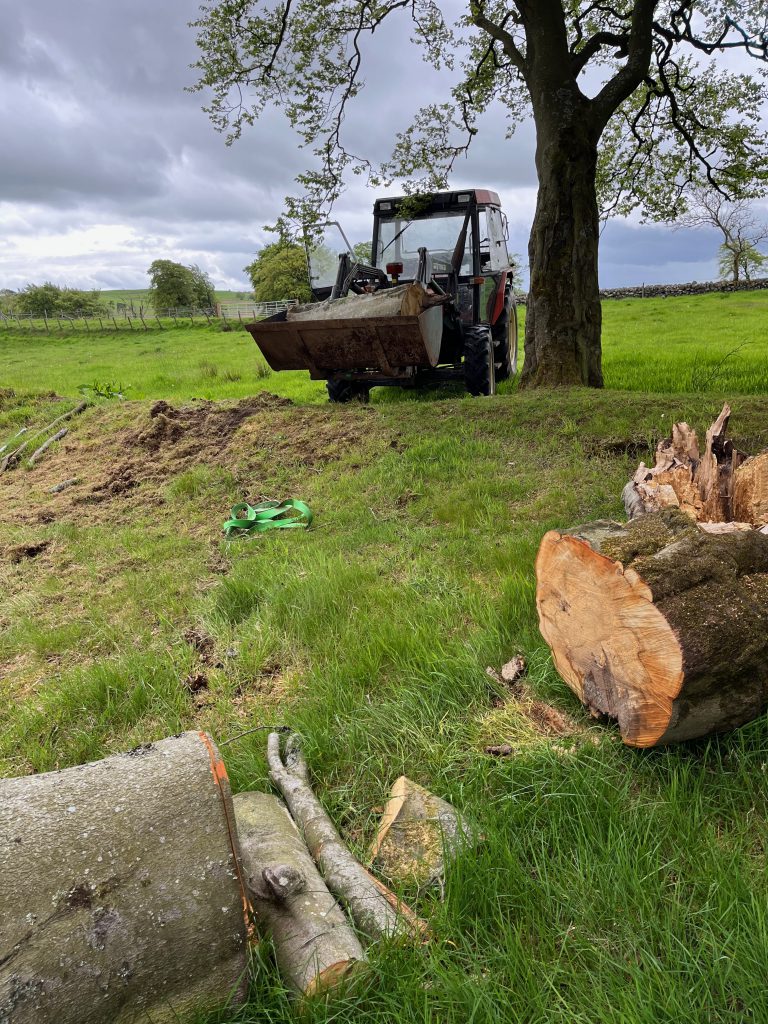
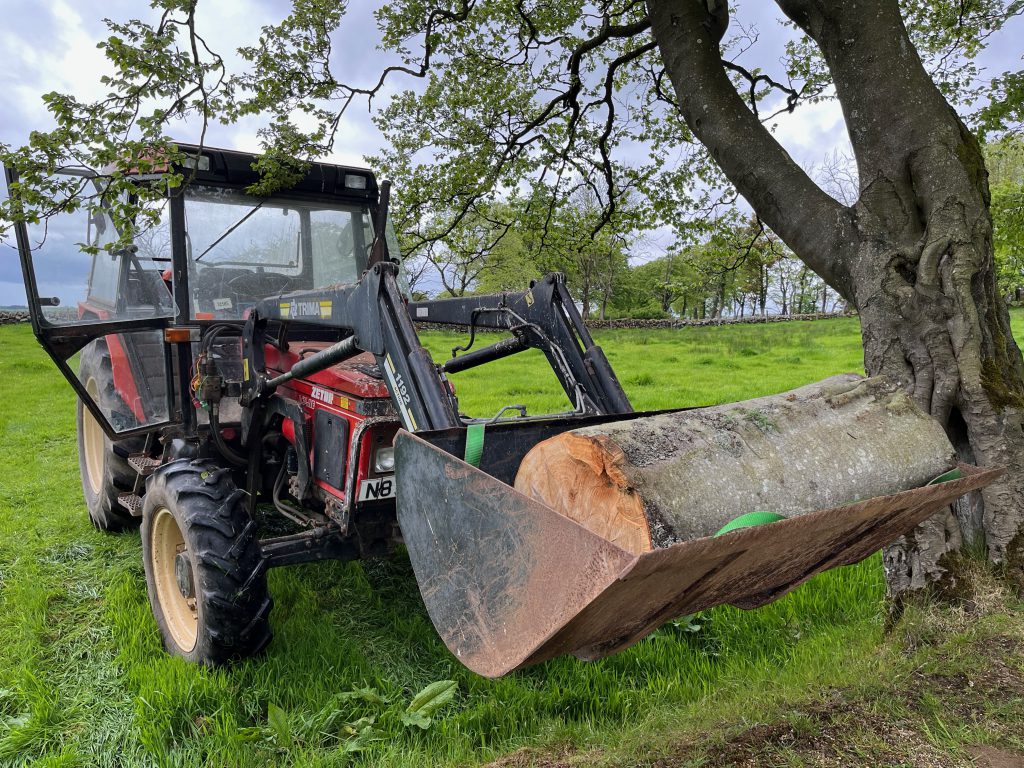
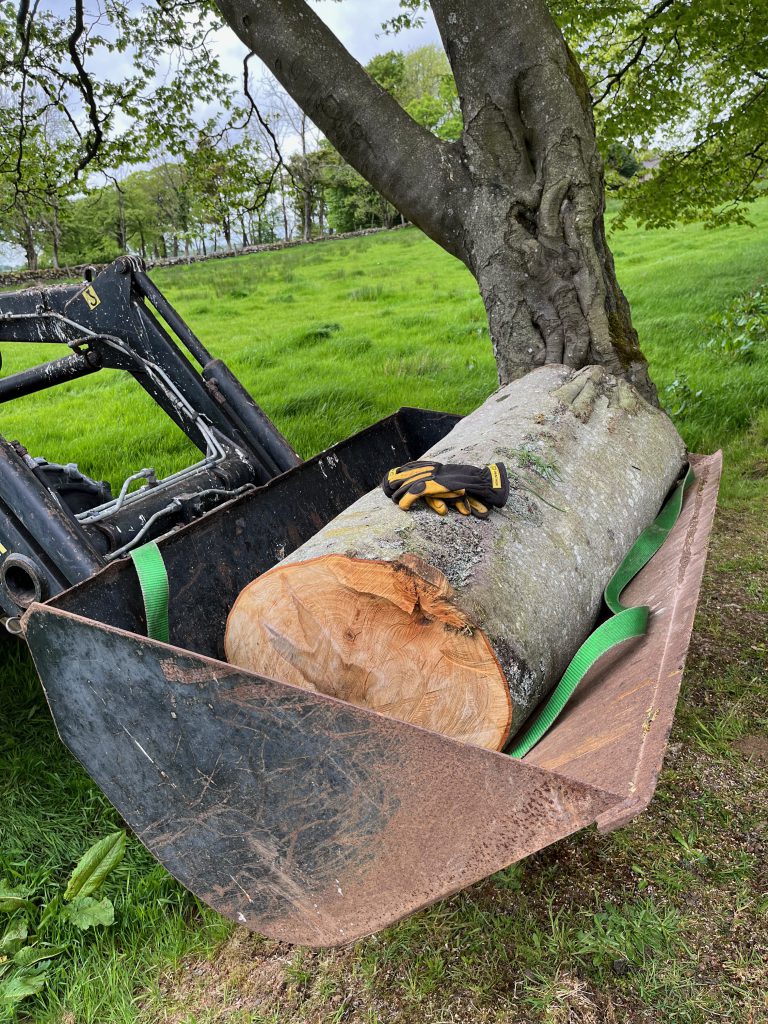
All cleaned up like new – the fence needed some new posts & staples but it’s now stock proof again. The stump and a section of trunk are left to keep bugs & critters happy:
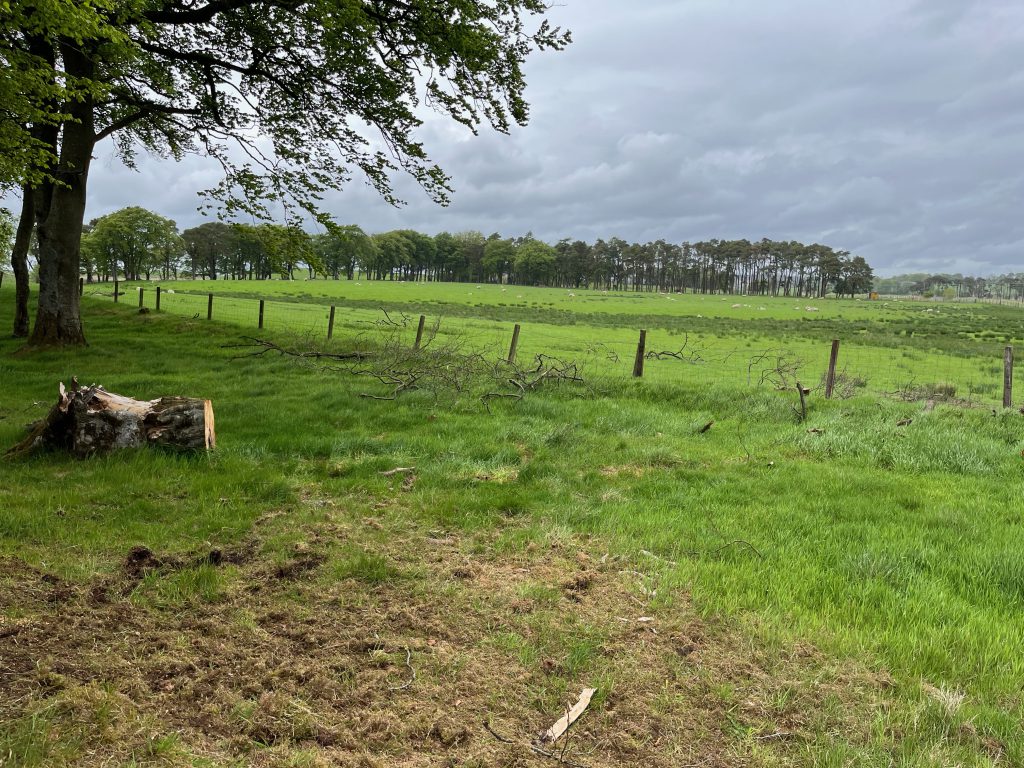
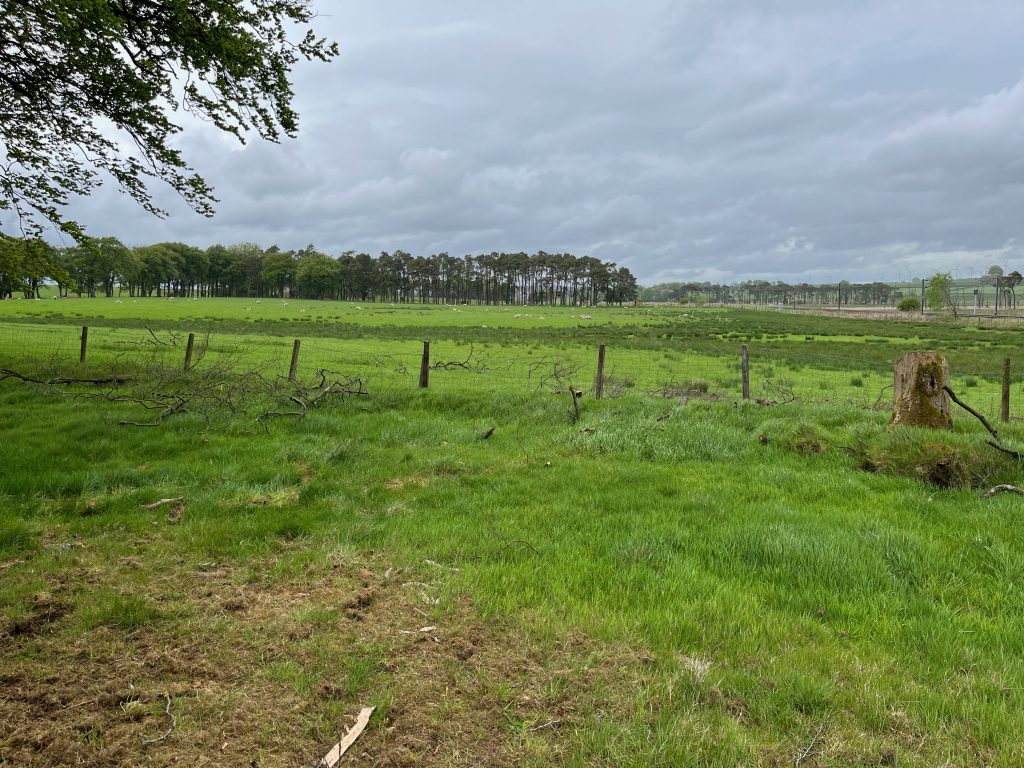
Will add posts on progress when milling the trunk sections….
Some pics on a range of wood-related things I’ve been working on recently.
Bringing home the last of the Beech tree 2019, finally! Dealing with the massive trunk & stump sections – they’re to be sealed, slabbed and stored away for milling next year…
Some nice Oak Sleepers brought over by a friend, which I’m experimenting with – hopefully going to be some chunky tables, benches and maybe other things too.
Slabs from old Beech wood that’s gone a bit soft with white rot, and some slabs from decent beech that’s been drying for about a year – more tables coming soon hopefully.
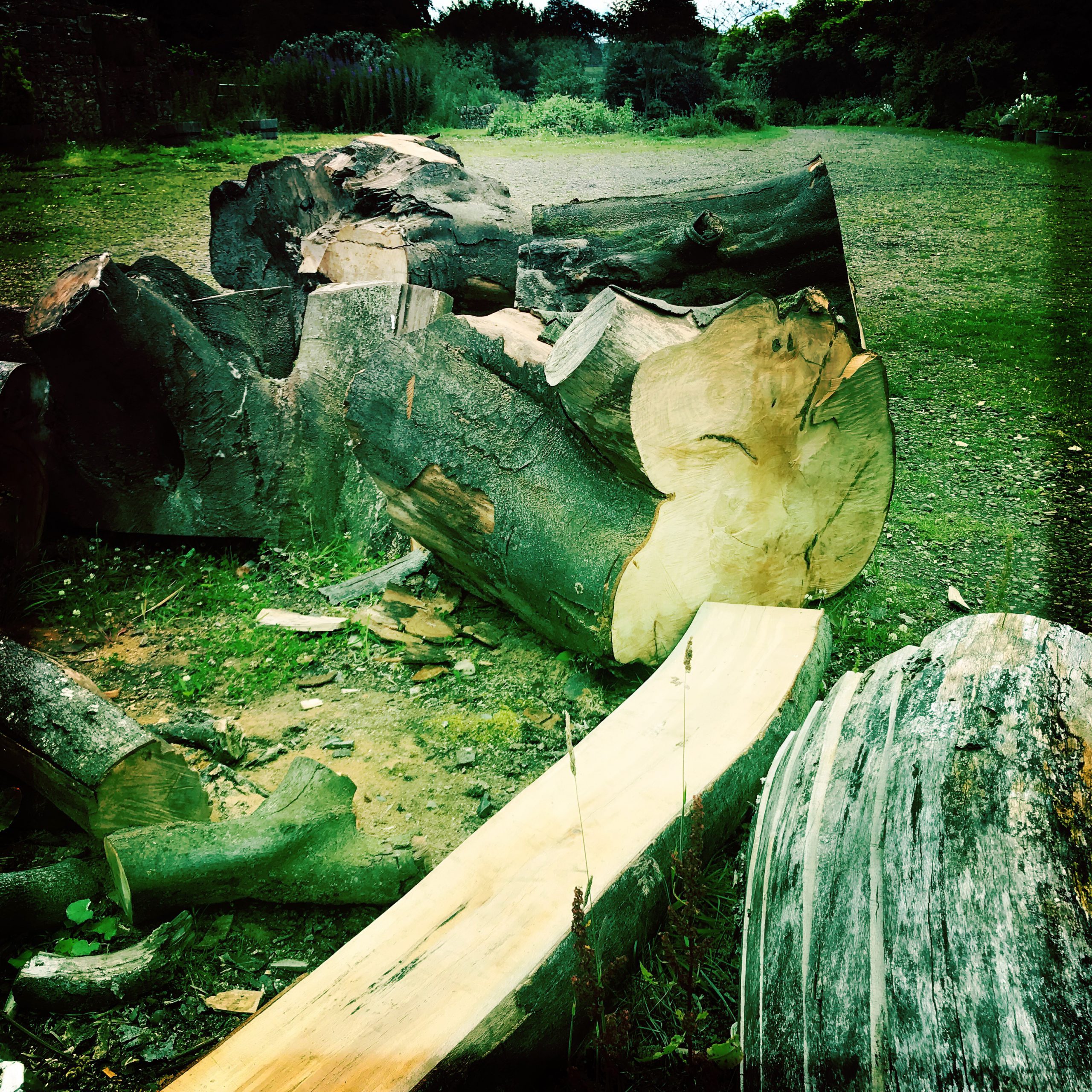
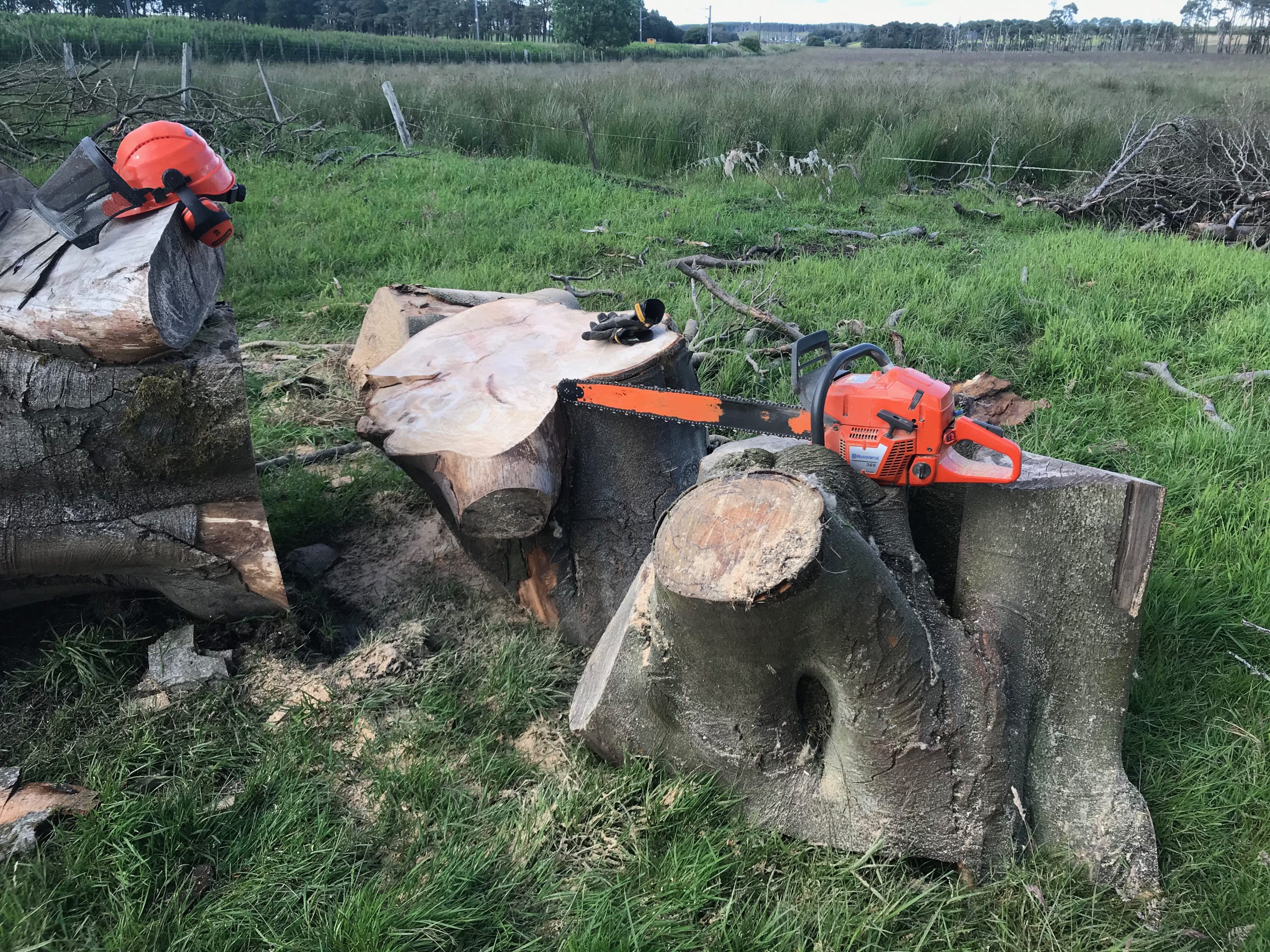
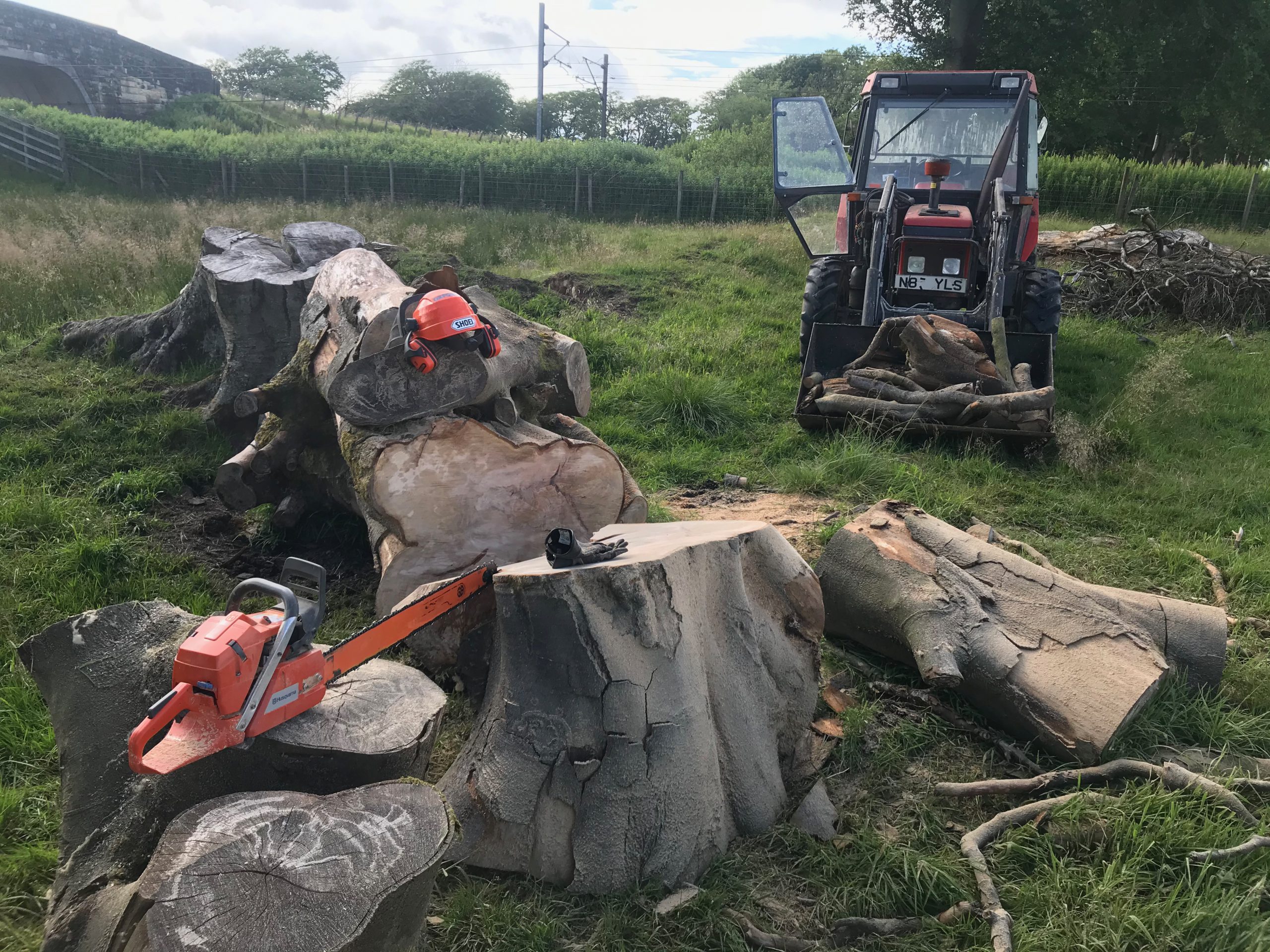
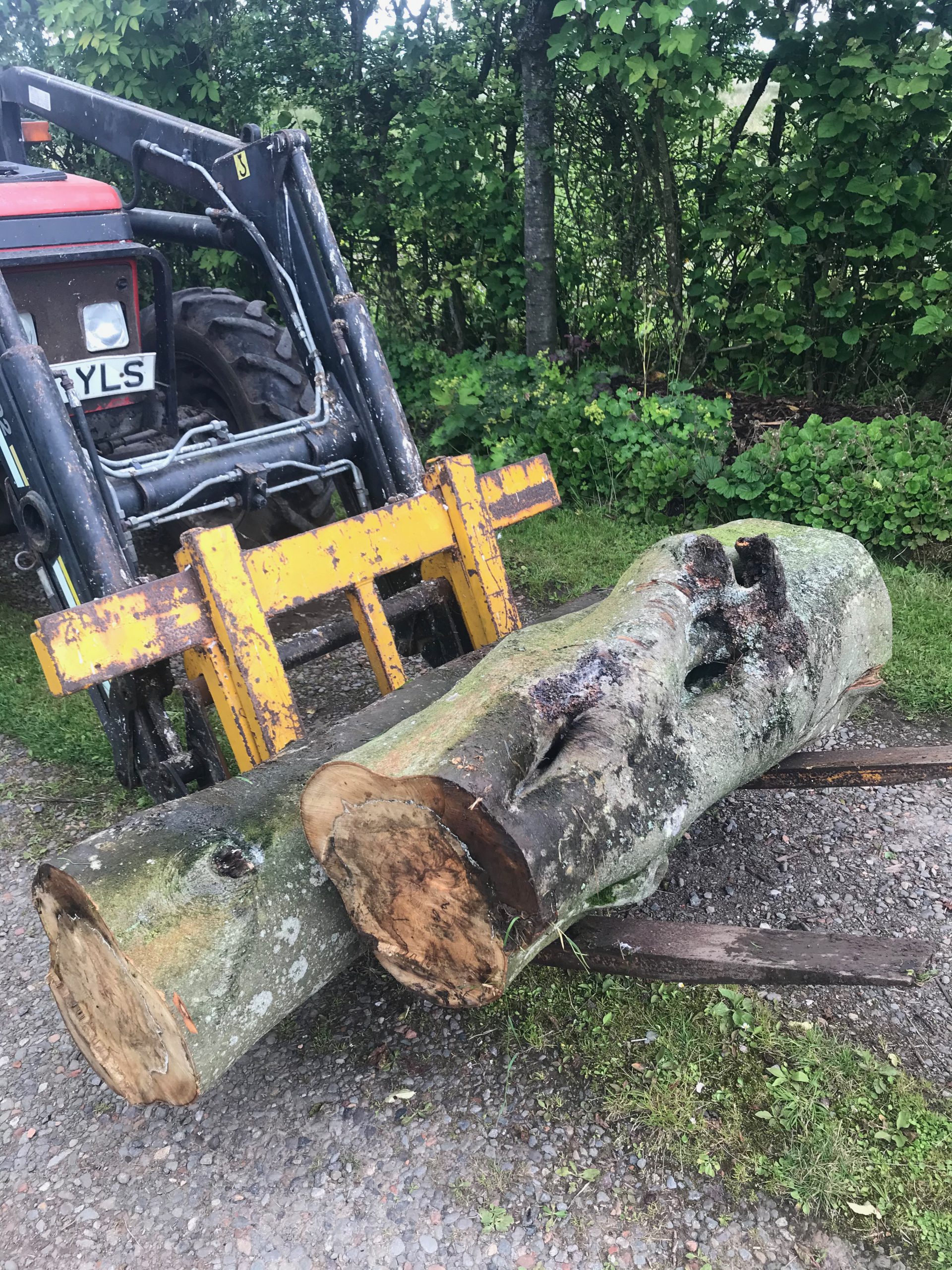
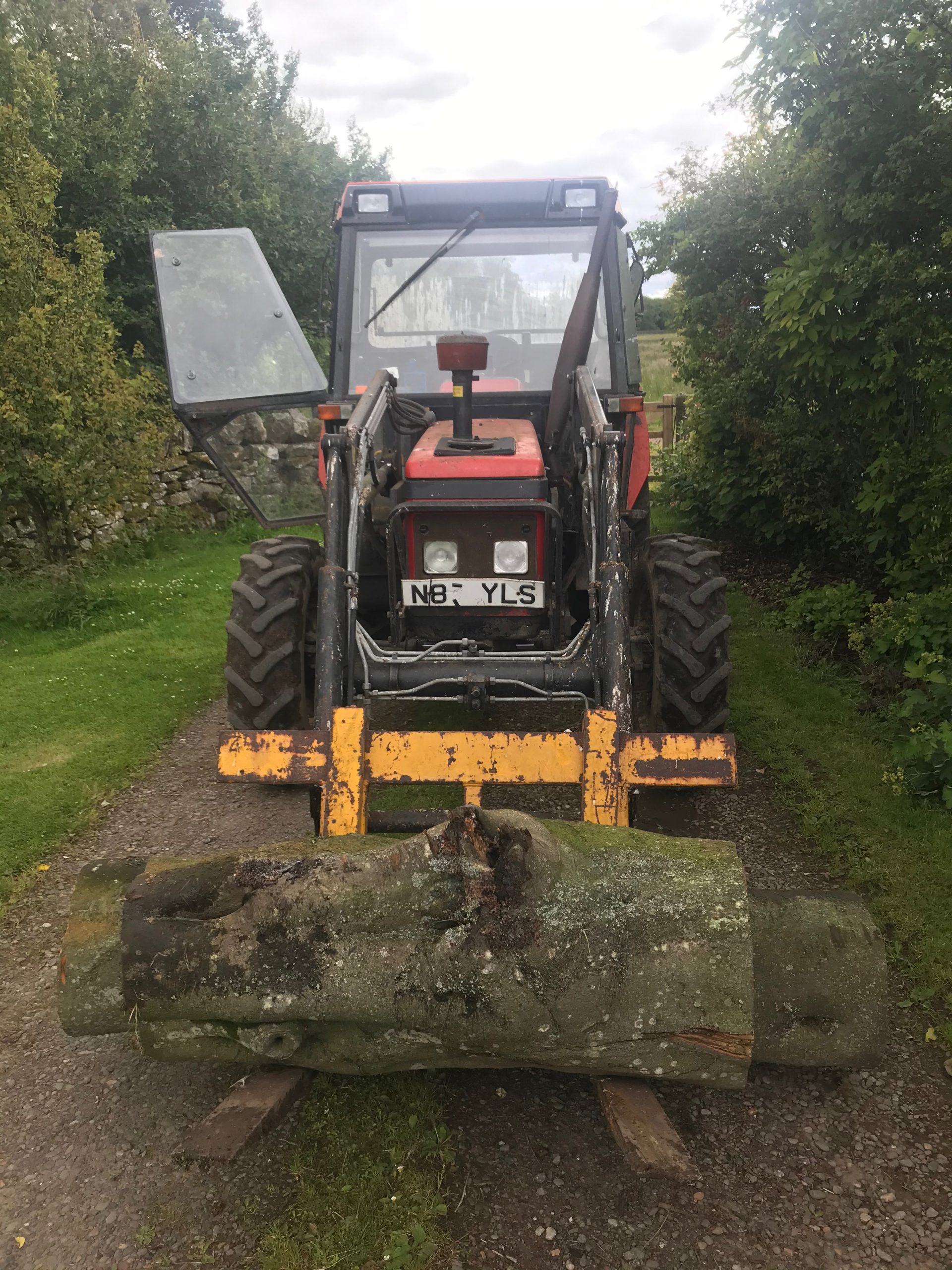
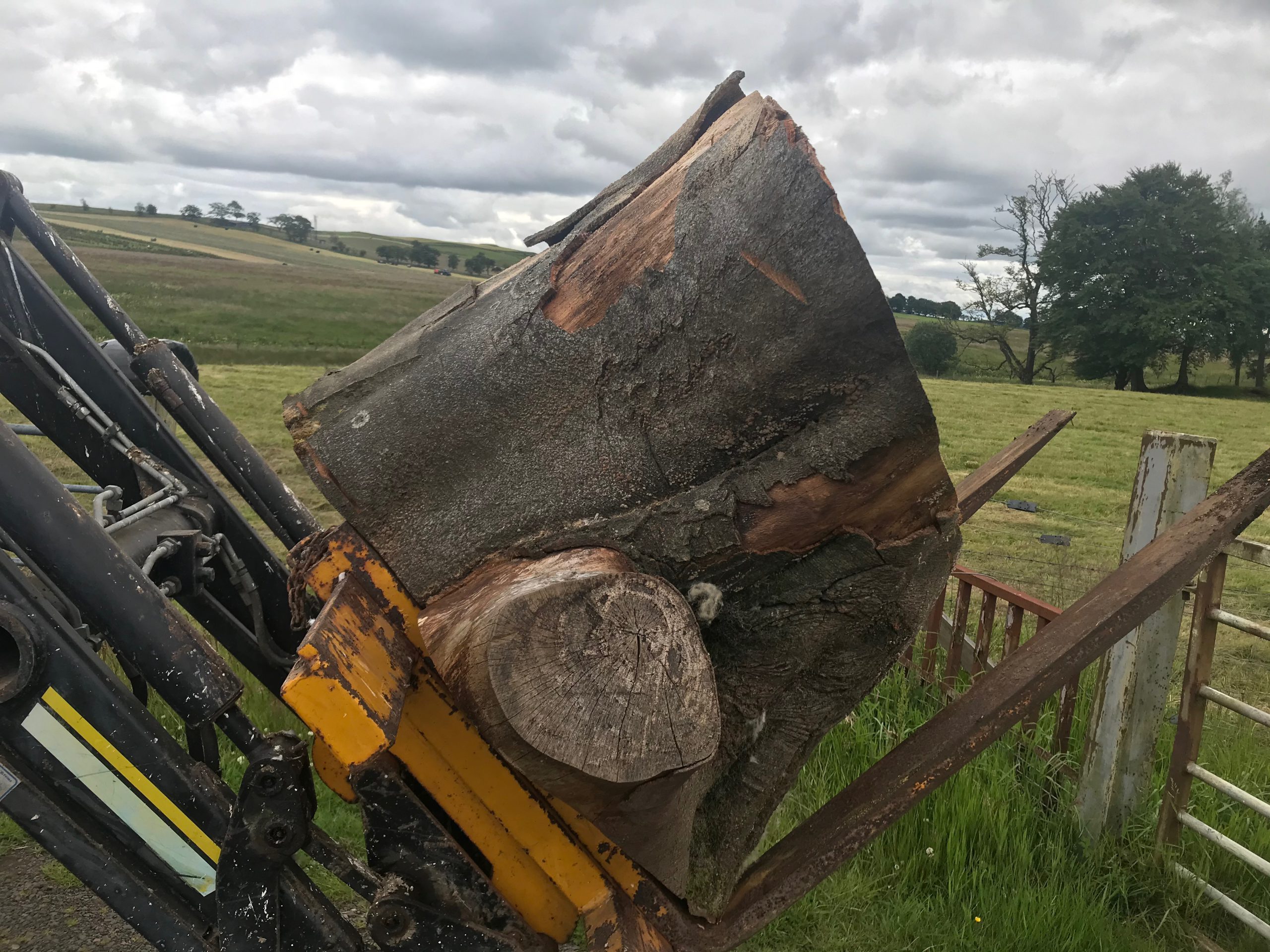
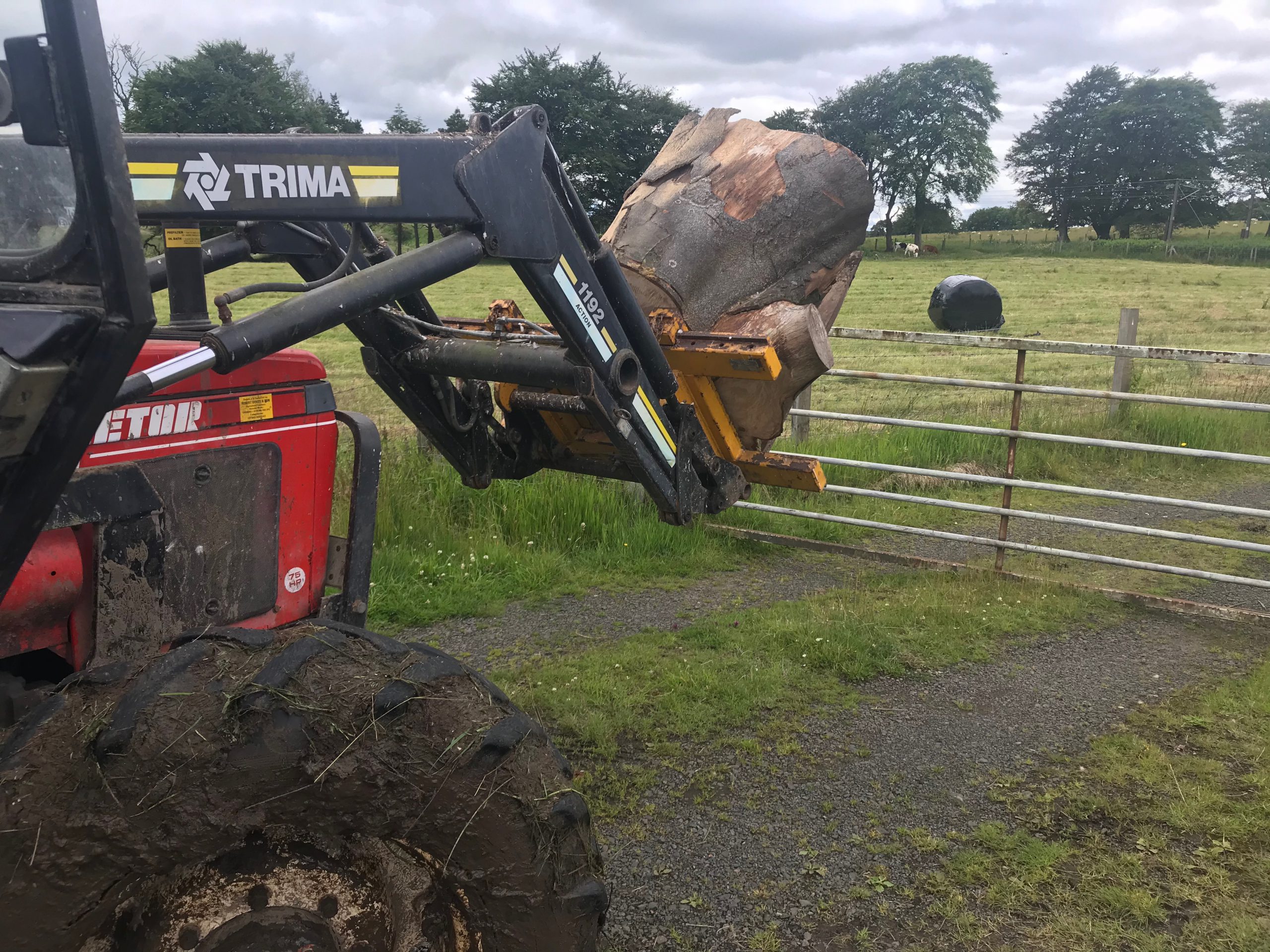
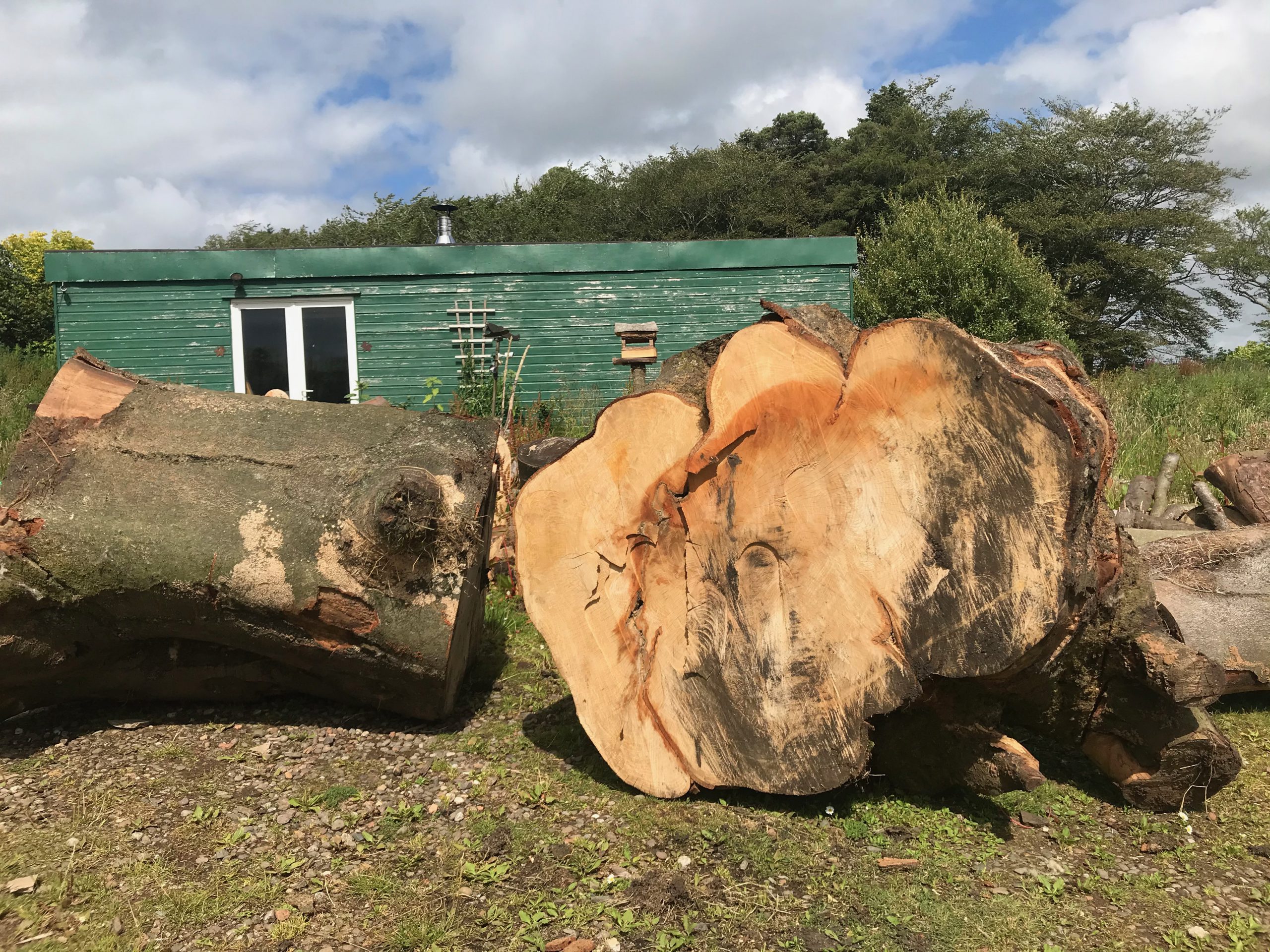
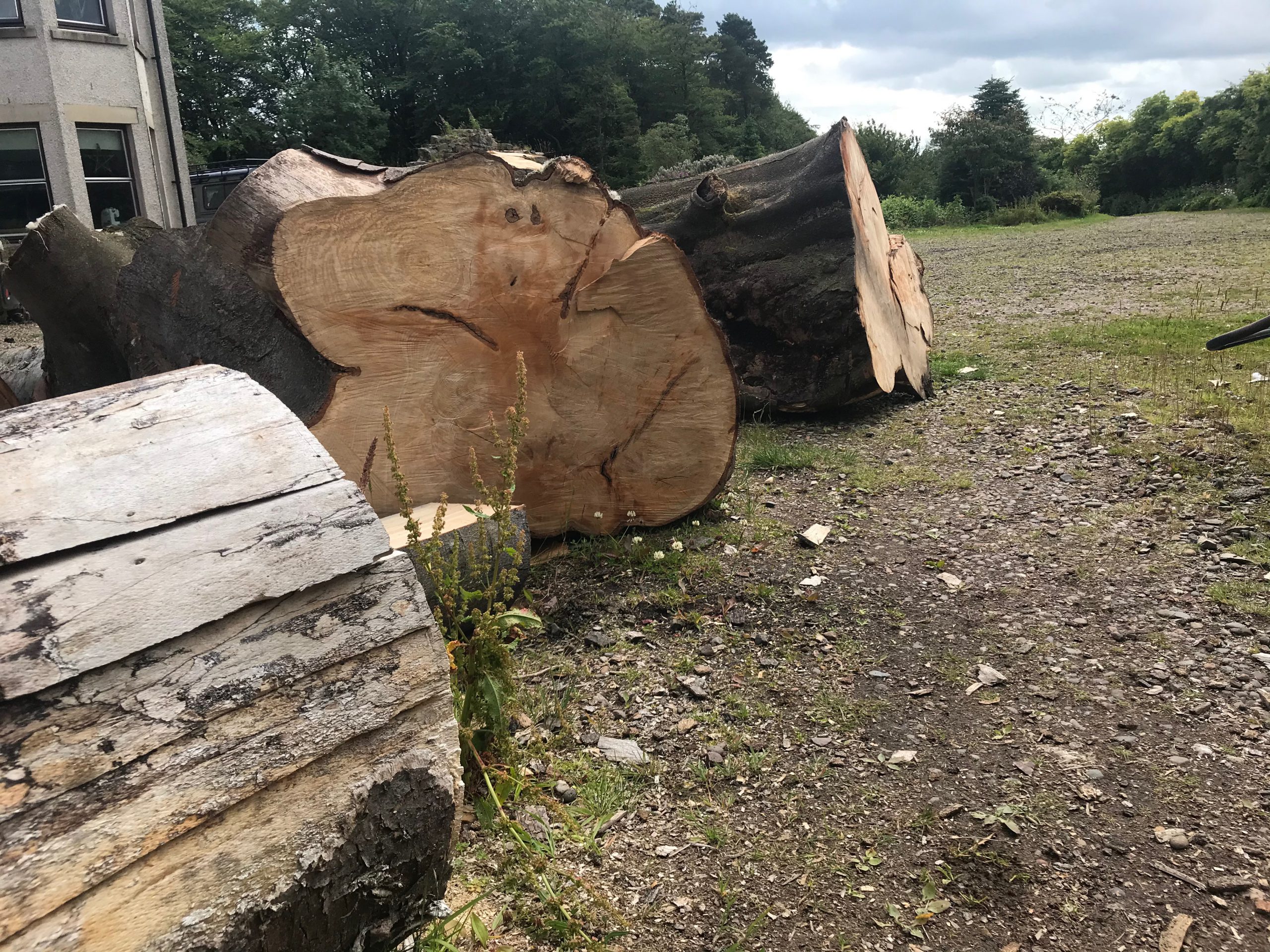
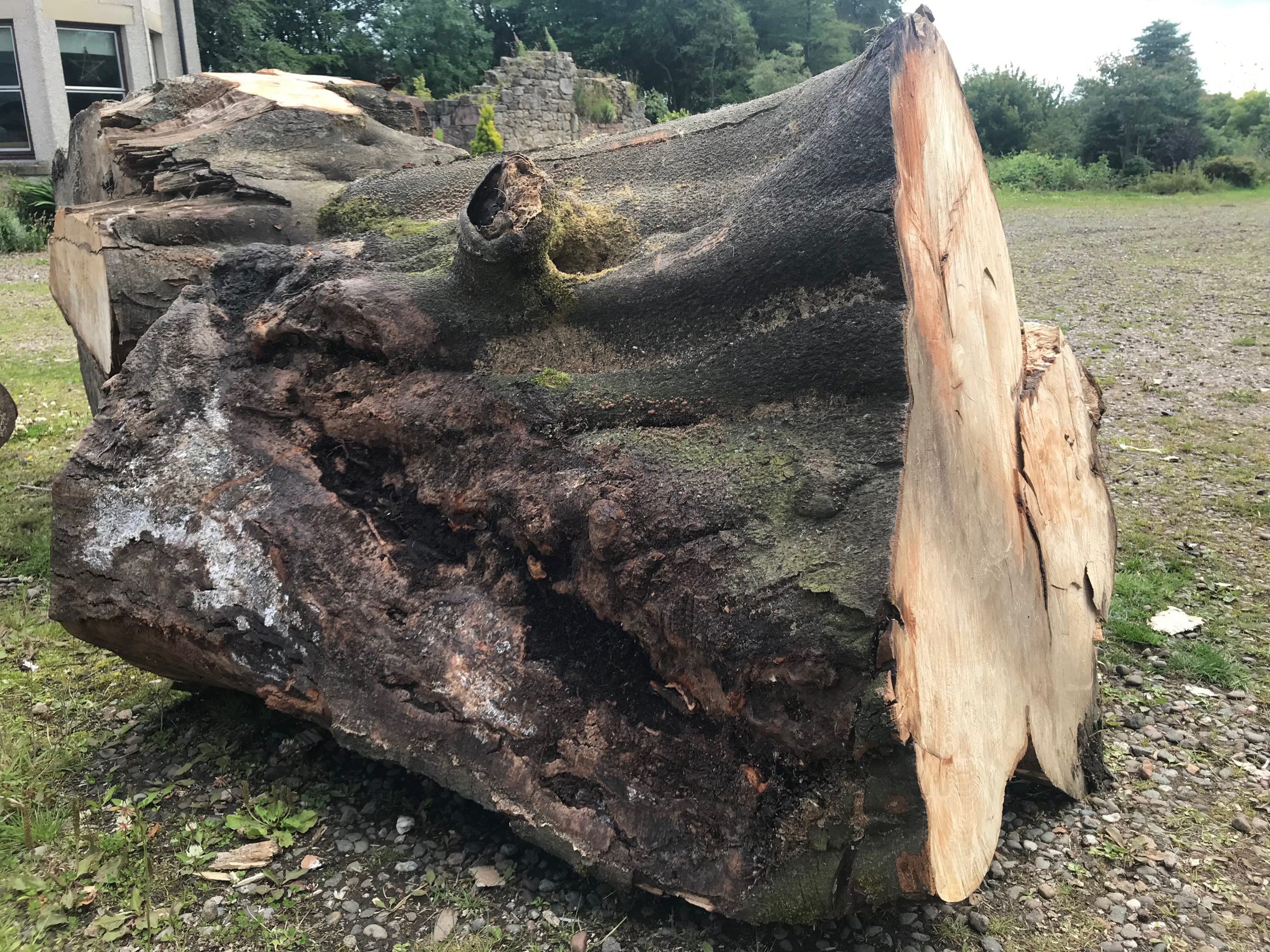
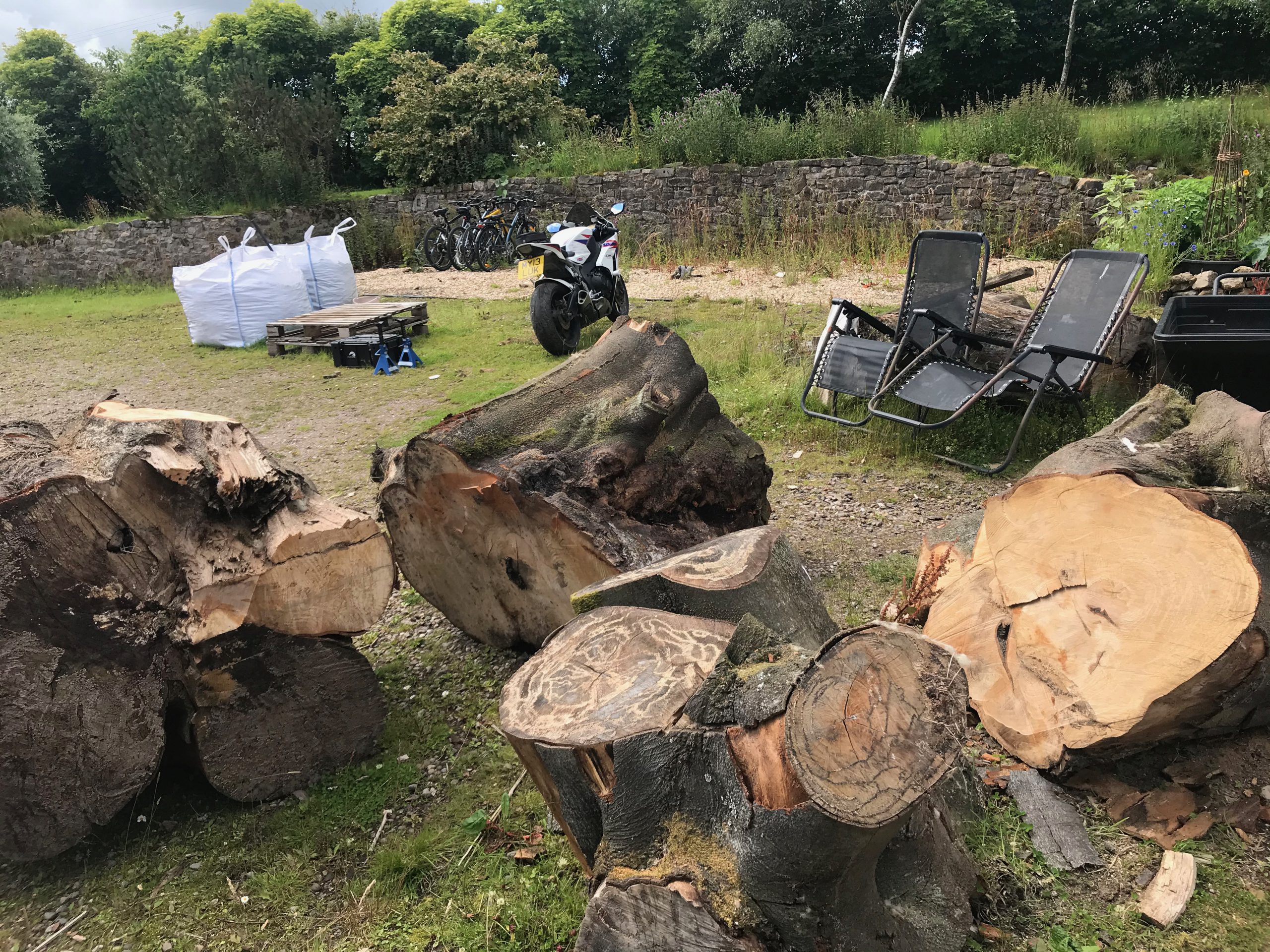
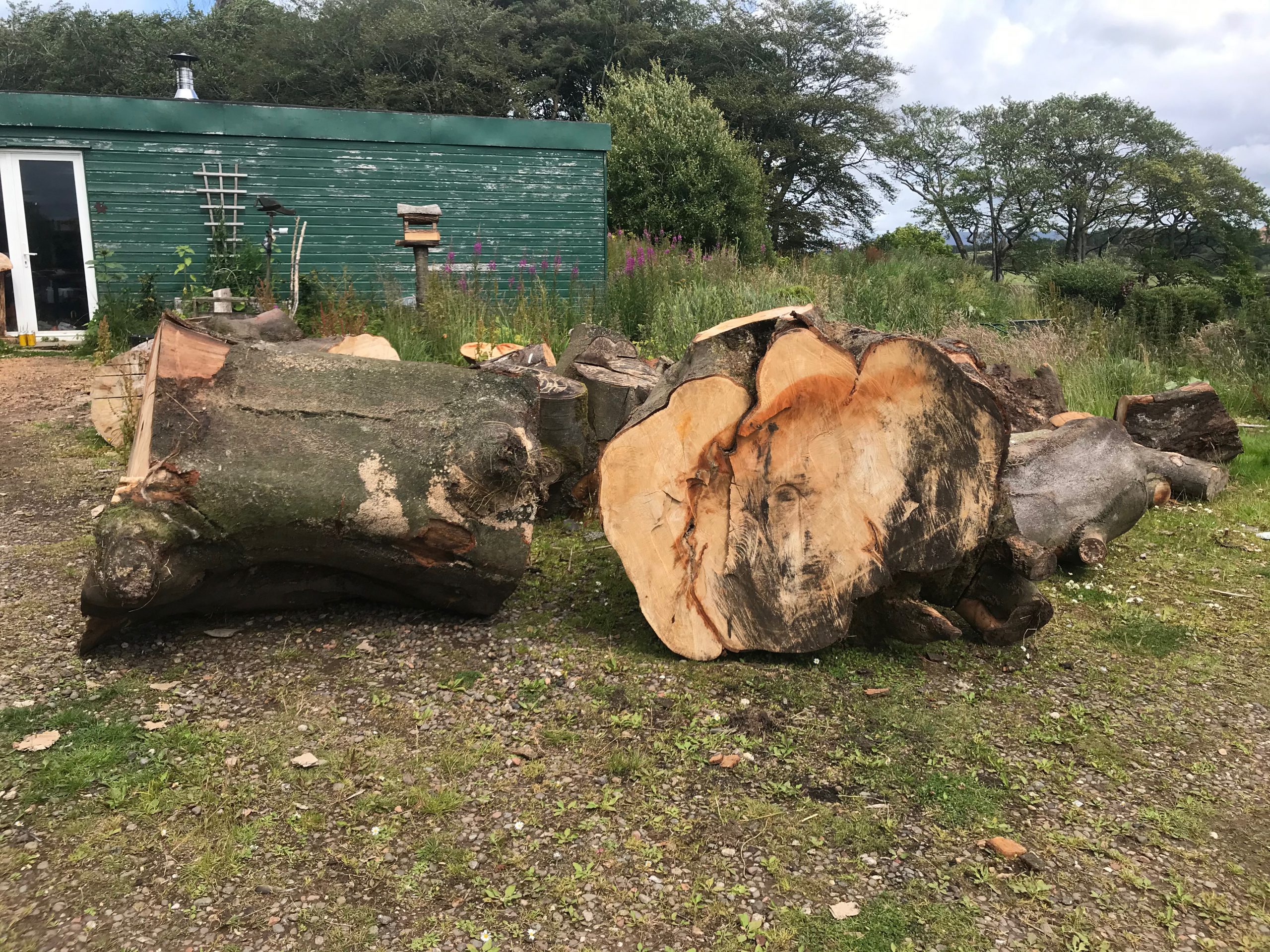
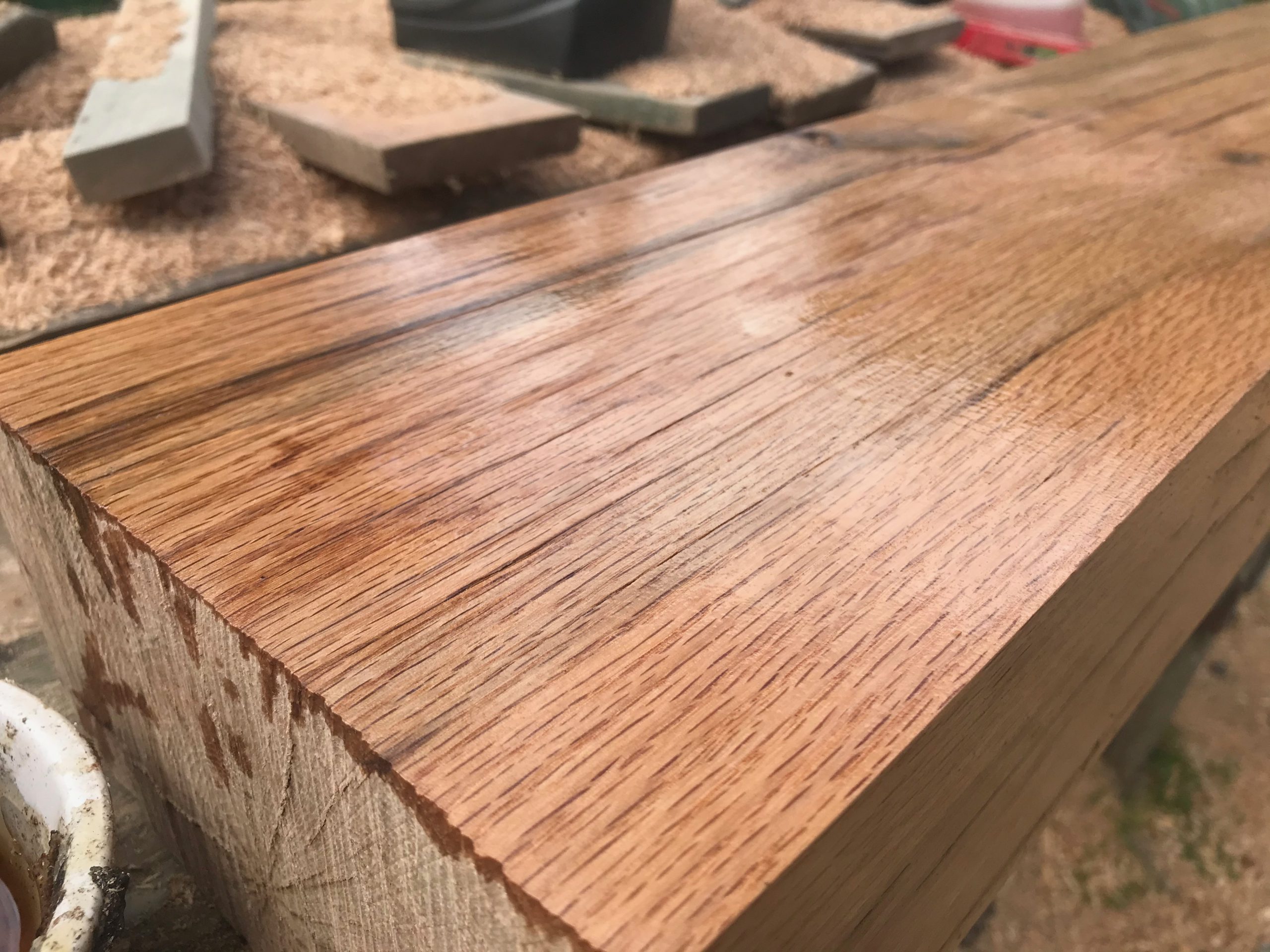
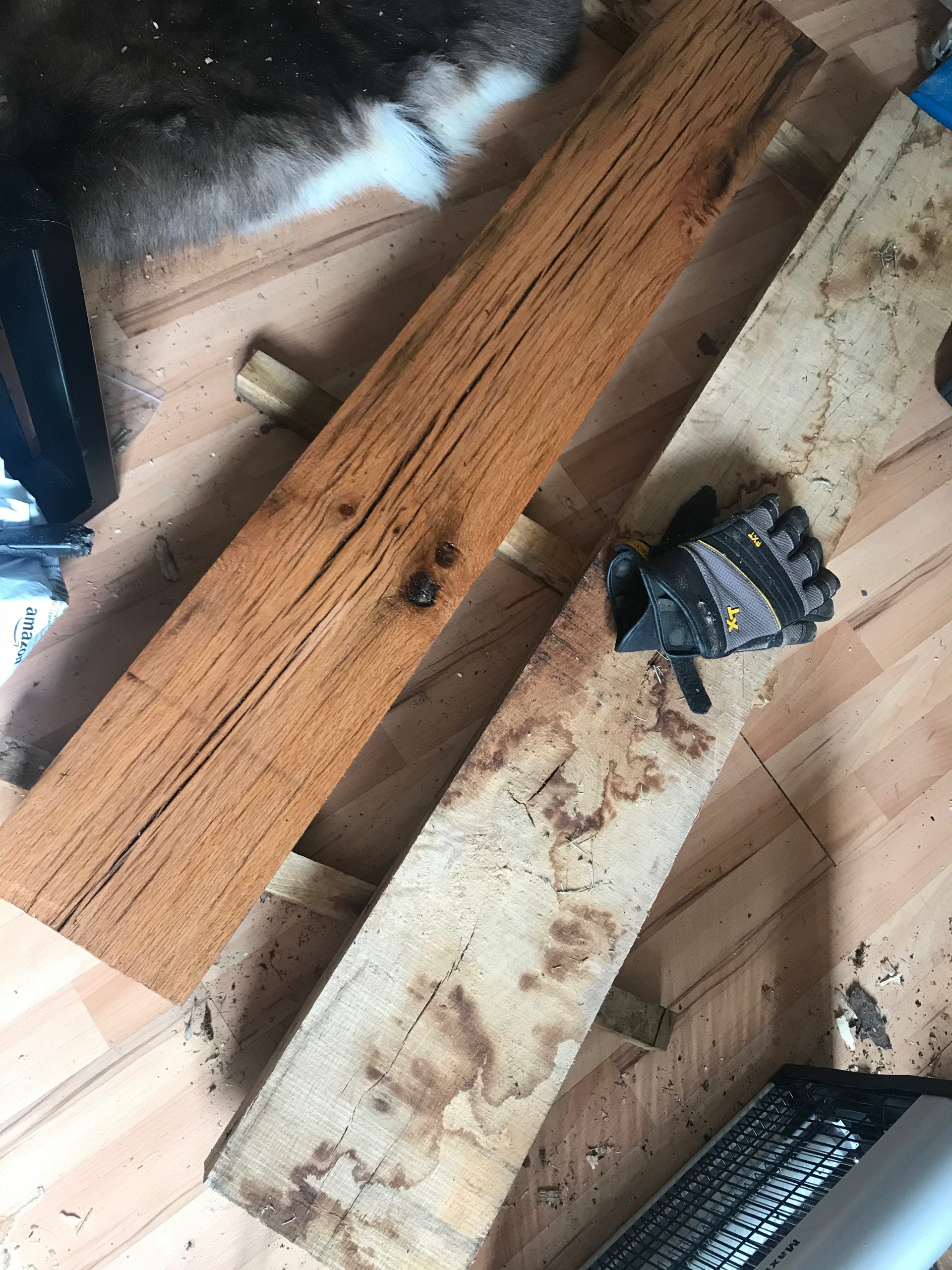
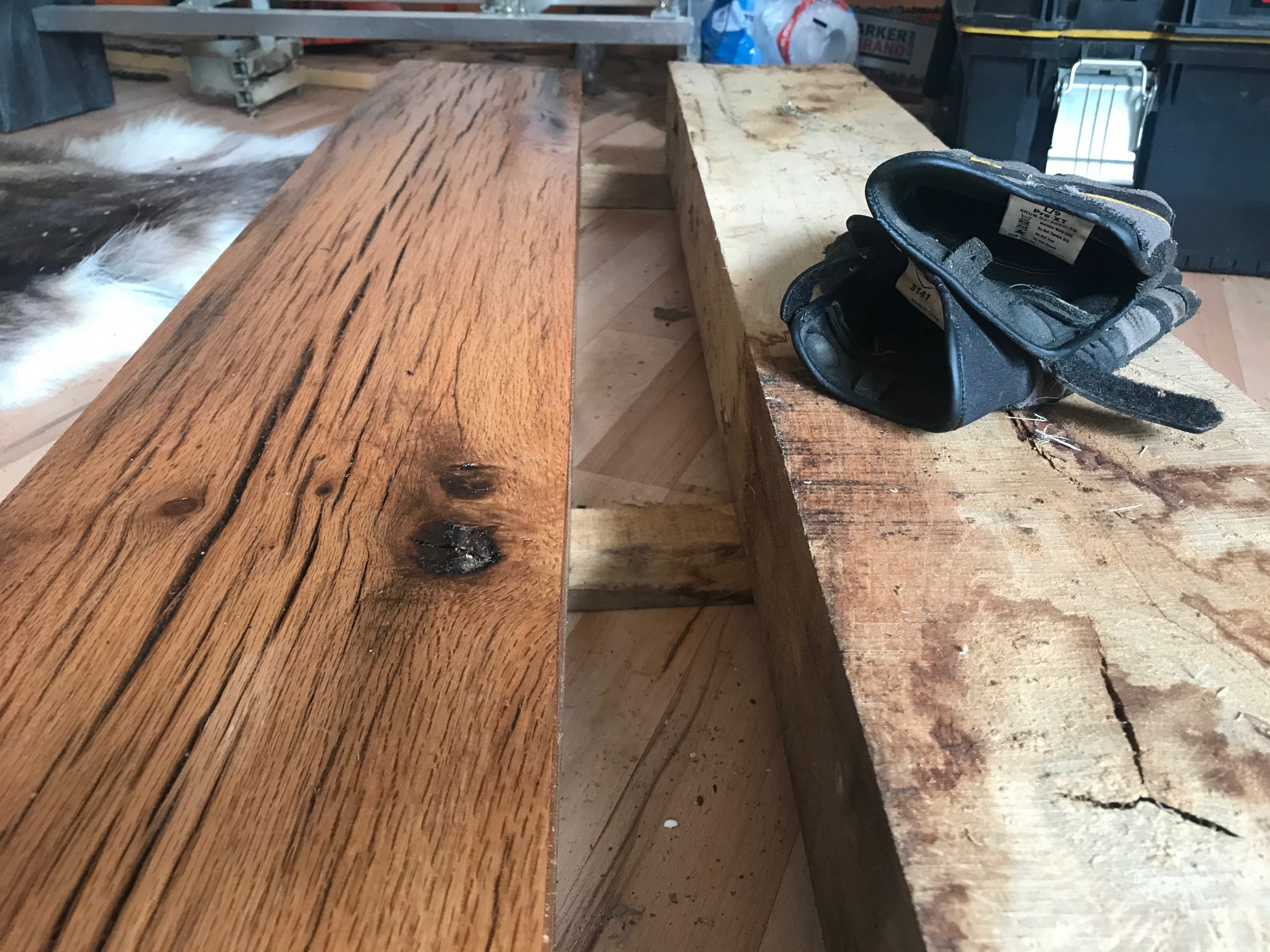
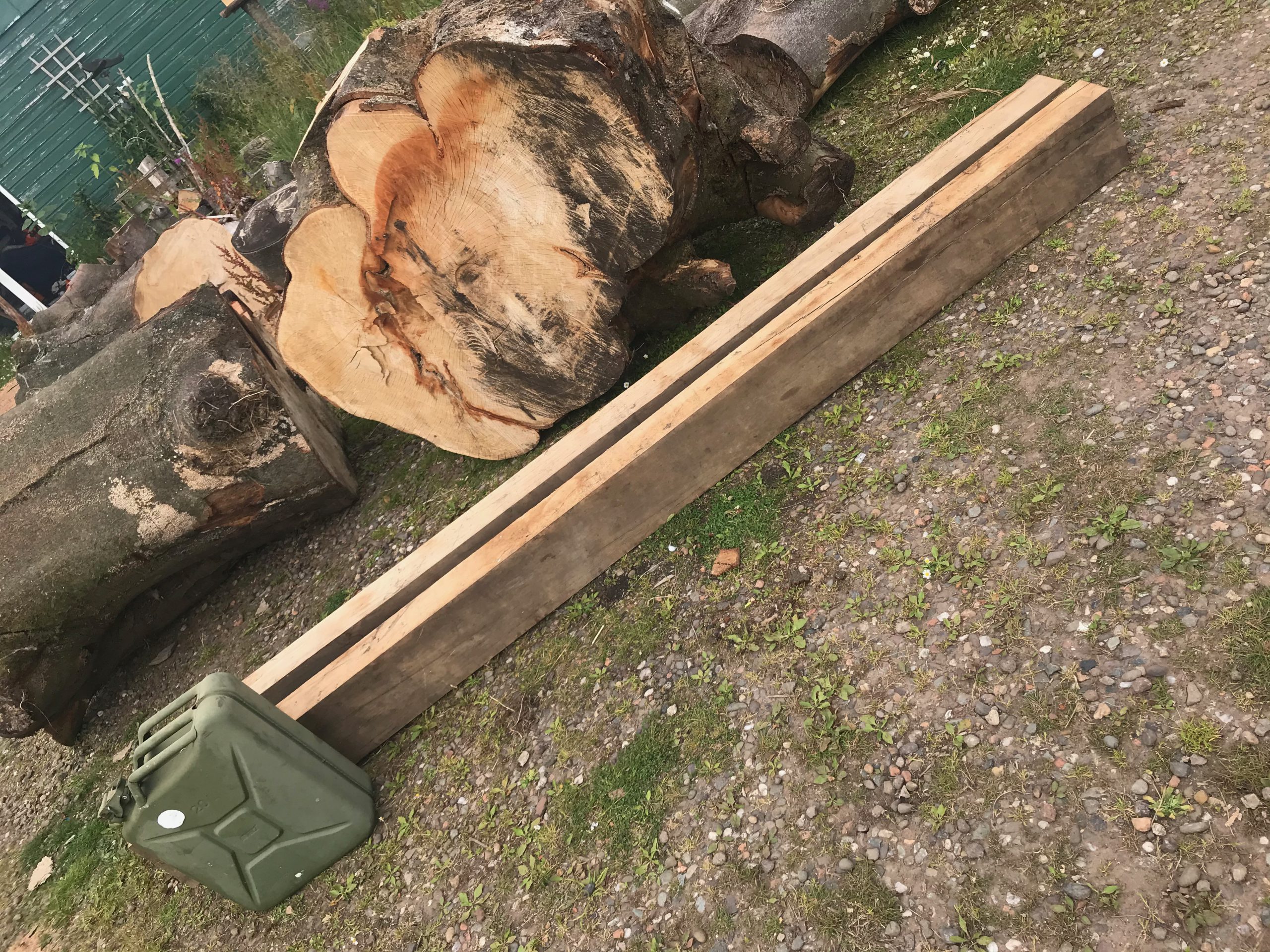

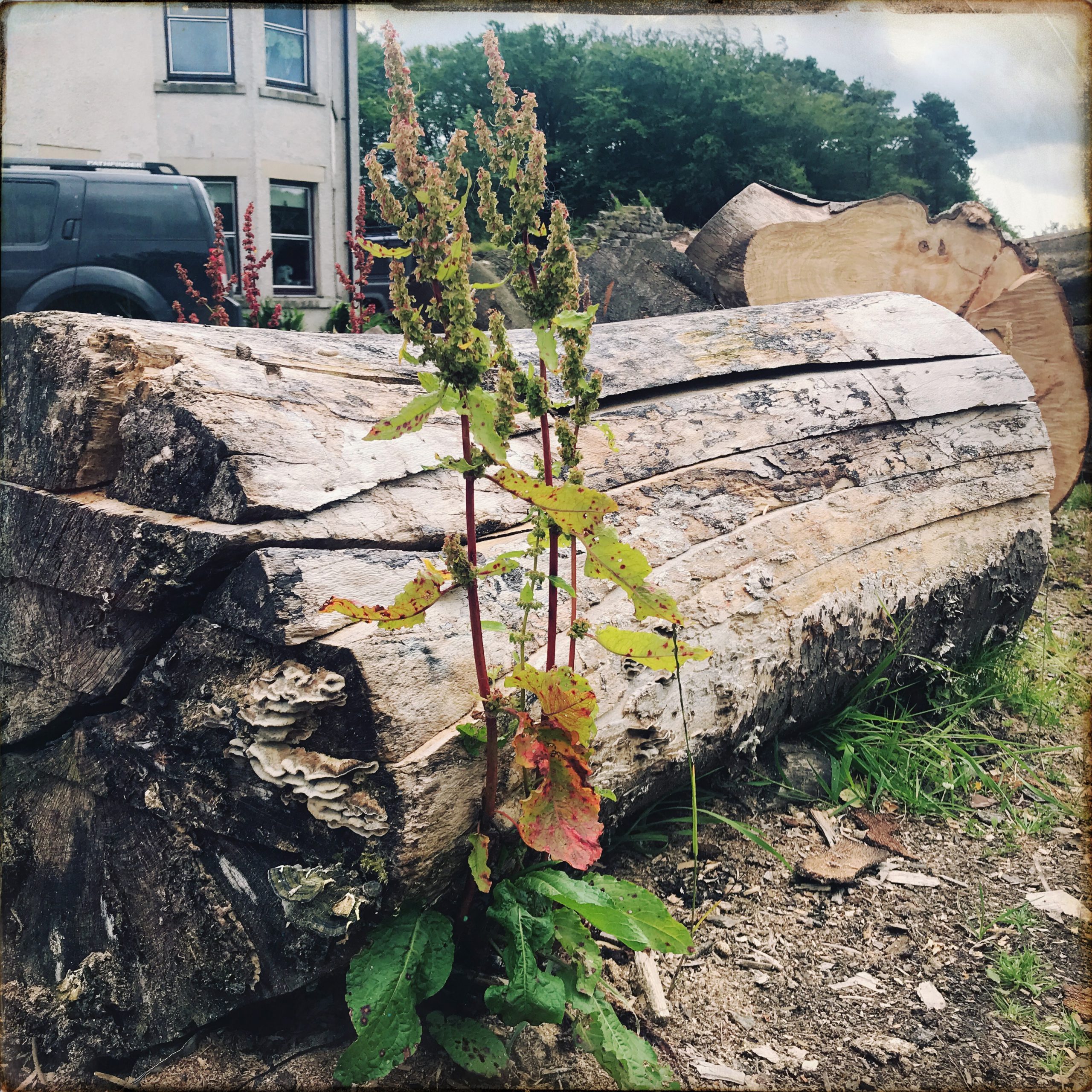
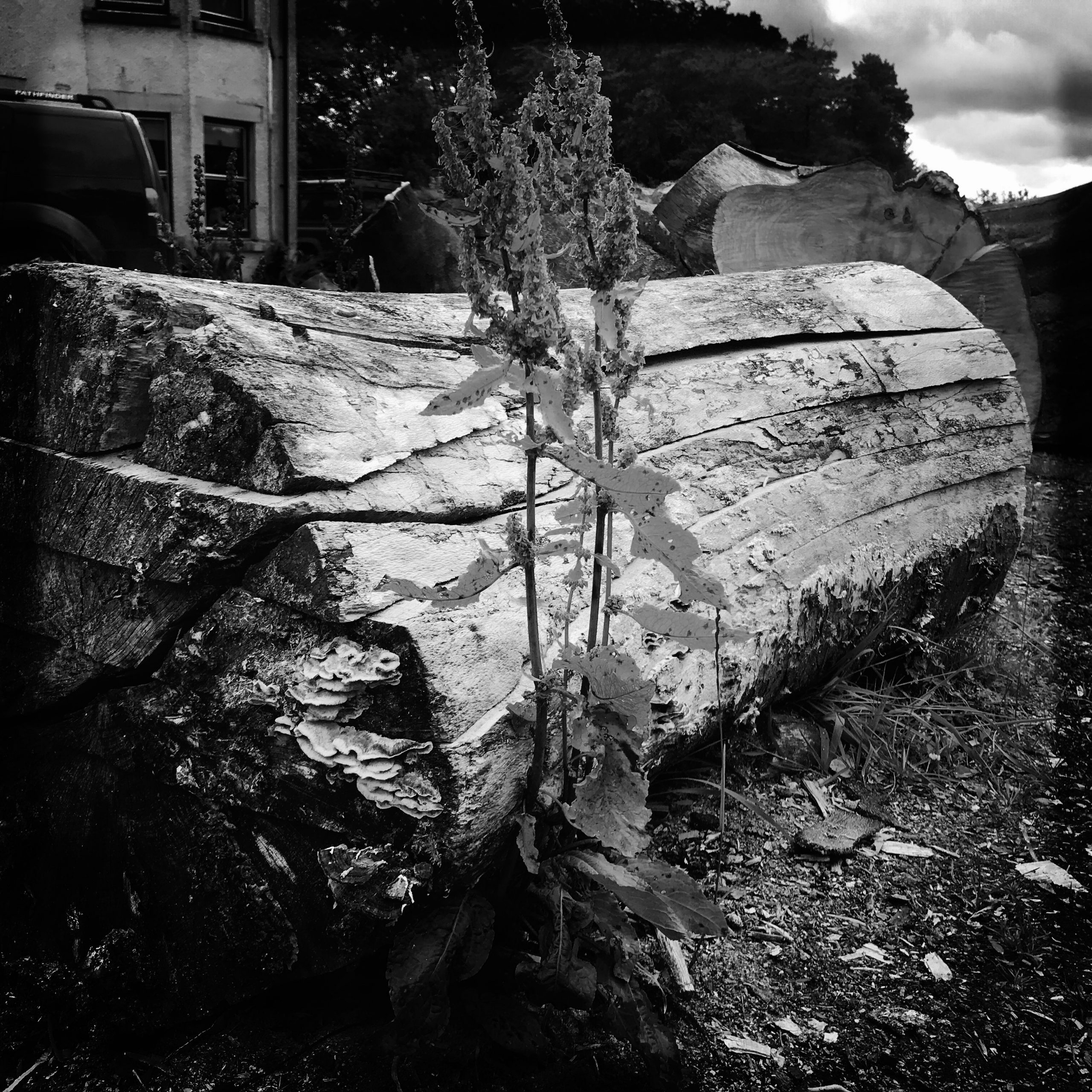
Some pics of a fallen beech tree being chopped up for firewood and milling.
One half of this tree had fallen on a neighbours track, and I spent a sunny afternoon self-isolating with it and a couple of chainsaws.
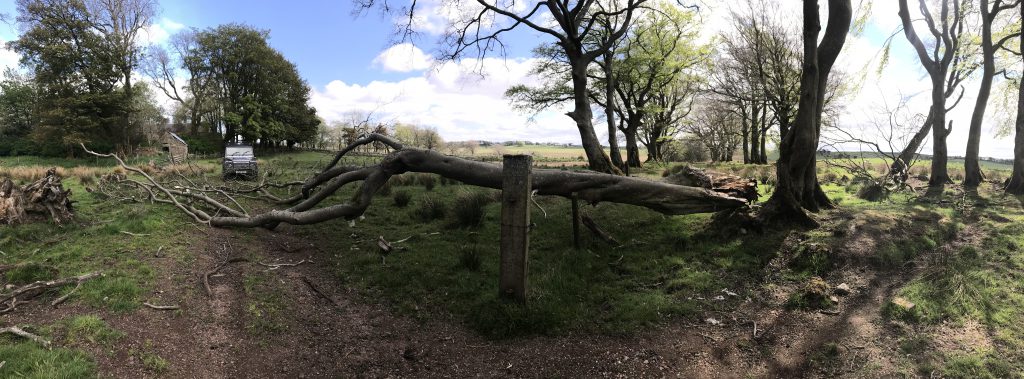
The “before” pics… it looks like a branch in these shots, but it was quite a lot of wood.



After some limbing and bucking and a mild case of sunburn:



Gear – the Husqvarna 365 with its 20″ bar on and a recent chain from chainsawbars did almost all of the work no problem. My old Mountfield was having an off-day.

Root cause analysis – the lower 4 foot was rotten through.
The other half of the tree is still standing and looks to be ok though.

The good bits – I left these nice and straight looking 6 and 4 foot sections in place to bring home with the tractor later.
The ends have been sealed and I plan to mill them in to 2″ planks and maybe some thicker slabs

The (panoramic) aftermath

And a truck full (ok, not quite, it was a long afternoon) of firewood that was delivered to a neighbour

Random Landy pics



A family friend gave me a Land Rover boot-load of old Yew wood. It’s from a very old tree, is very dense and has loads of character.
The wood had been stored in her garden for several years prior to me getting it.
There were a lot of marks, holes and cracks to work around. It also felt very hard to cut and turn, possibly due to the complex grain patterns.
I was pleased with the end result and the different colours & patterns, and have enough wood left to make several more, hopefully.
NOTE: I wore a decent mask and kept the dust extractor on while turning this, and removed as much of the bark as I could first – apparently Yew dust is highly toxic.




















Here are some pics and updates on my recent attempts at milling my own wood. This had been on my wood-related TODO list for a long time. The aim was to free up some room in my woodpile by creating planks that I can then try and make things out of – and to have some fun doing so.
All of the wood is local beech, I’m using up old trunks first but plan to do some green milling later, including milling another fallen tree with a nice straight trunk “in situ” then bringing the planks home to dry.
Chainsaw: you need a powerful chainsaw for milling, especially if you want to run a long enough bar to mill wider trunks, which I hope to do later. I really really wanted a large Husqvarna or Stihl but the cost for something of the right spec for this job was waaaay over my budget.
Searching for >60cc chainsaws I found this one by Parker:
https://www.amazon.co.uk/62CC-20-PETROL-CHAINSAW-CHAINS/dp/B00M9BBTT4
£80-odd quid for a 62cc Chinese chainsaw with 2 year guarantee and some extras bits ‘n pieces!?! Sounds far too good to be true, but further reading led me to reviews of similar cheap gear being used, mostly with good results, and folk referring to it as Chinese Milling, or “Chilling” 🙂
Bar & Chain: the 20″ bar that came with the Parker was ok but too small and the chains were cross-cut. I ordered a 28″ bar and Archer ripping chain from these guys – very happy with the parts and the service:
https://www.ebay.co.uk/str/chainsawbarsltd
Mill: there are some very cheap Chinese mill, bar & chain sets on eBay, but I went for this Eco Mill one which gets lots of good reviews:
https://www.frjonesandson.co.uk/products/eco-mill-36-chainsaw-mill/
Pics of the end result – cheapo Chinese saw, 28″ bar, ripping chain and EcoMill together:
The first cut is not only the deepest, but the most important and most difficult too – I tried the old approach of screwing a straight plank to the top of the log, then running the saw/mill over this to give me a flat initial cut.
It went ok, but I think the log rolled a little towards the end – it was only small so easy done. This means that all subsequent cuts follow the same slight curve – the planks are still ok, but a lesson learned. These planks are narrow enough to run through my planer/thicknesser later anyway.
The waste/kerf from the ripping chain is noticeably smaller (narrower) and much finer than with a cross-cut chain. The saw runs surprisingly well and starts really easily. It makes a fair bit of noise but for the money it’s superb. I didn’t try to rush or force the cut, pretty much let the chain pull itself through, and I am very happy with the results.
Pics of the first small-scale test – the chicken was grudgingly impressed.
This time I tried using a bigger plank sitting on a crate at either end for the first cut, with the log sitting unattached underneath but secured with a load of wedges to stop it rolling/moving. This took longer to set up but worked much better.
Here are pics of a similar-ish setup I use to flatten large slabs. It’s a “jig” made from a couple of clamped planks (from my daughters old bed), with a “sled” made from a couple of 30mm angle iron sections joined together with Gorilla Tape & wooden blocks to keep it the right width and stop it coming off the rails. All of this keeps the router level while I run it from side to side, moving the sled up and down the jig to flatten the wood.
The router bit is a “1/2-Inch Shank 2-Inch Cutting Diameter Double Flute Carbide Tipped Cleaning Bottom Router Bit Cutter“… so there you go. It’s now done quite a lot of work and still cuts quickly and easily.
This setup is very versatile – I used it to create these too:
Other stuff….
TODO: make something useful from those planks….
Pics of three tables I’ve made recently – all are from the same beech tree that fell over in the wind about 4 years ago.
– this one is being used as a plant stand. It was narrow enough to fit through the 12″ thicknesser then was finished with a hand planer. The legs are beech branches.
– this one has some nice spalting lines around the edges. Flattening this was the first test of my home-made “router sled jig slab flattening contraption” (not sure what to call it, but it worked!) which I’ll post details of another time.
The hairpin legs were made by Designer Legs
– this one weighs a ton and has some interesting features and curves.
It was initially cut from a massive log with a chainsaw “freestyle” as my milling setup wasn’t ready at the time. There are still 2 or three slightly wider and more uniform slabs still to come from the remains of this log, hopefully.
The “router-sled-jig-contraption” was used to flatten both sides, then it was sanded (and sanded and sanded again) to a very smooth finish and varnished with a tough matt glaze.
These three-prong hairpin legs were made by Designer Legs too.
Some pics of a recently turned beech bowl.
This was made from a wind-fallen tree I chopped up about 3 years ago. I sealed the ends of some of the nicer logs and left them outside to dry out slowly.
This is the first bowl made from one of these logs, and I’m very pleased with the result – really nice spalting and not too many cracks, plus it was nice and easy to carve on the lathe too.
The unsorted selection of pics below show it on the lathe and on the log it came from, with the random traffic lamp for scale…